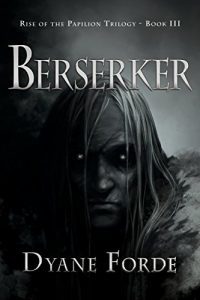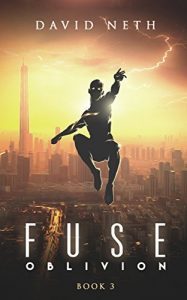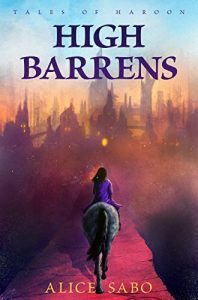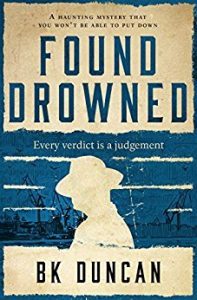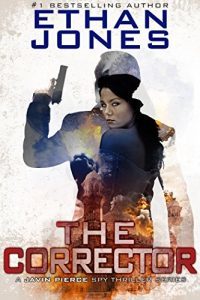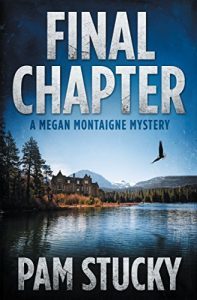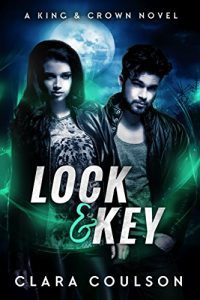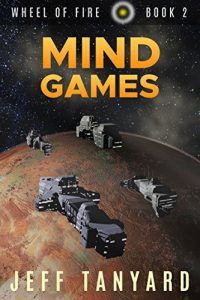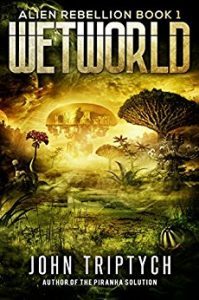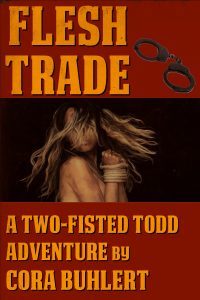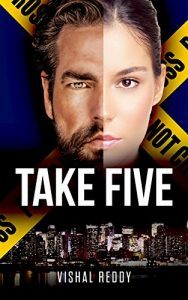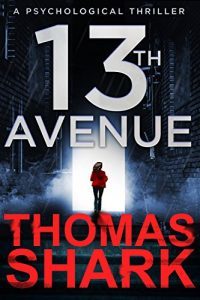Cora Buhlert's Blog, page 82
March 31, 2018
Some Thoughts on the Hugo Award Finalists, Part II: The 2018 Hugos
For my comments on the 1943 Retro Hugo Awards, go here. Meanwhile, here are my comments on the main event (sorry, long dead authors, filmmakers, artists and fans of 1942), the 2018 Hugo Award finalists.
For other comments on the finalists, see the discussion in the comments at File 770. Also at File 770, JJ has compiled a list of where the find the 2018 Hugo finalists online. Best novel nominee John Scalzi is delighted to be nominated and finds some kind words for his fellow nominees, too. Joel Cunningham weighs in at the B&N Sci-Fi and Fantasy Blog, while Andrew Liptak weighs in at The Verge. Newly minted best fanwriter nominee Camestros Felapton shares his thoughts on the 2018 Hugo finalists here. Meanwhile, a certain jerk who managed to get himself kicked out of WorldCon 76 months before the con, attended the public announcement of the Hugo finalists, managed to behave himself enough that he was not kicked out and still feels persecuted. He’s also been saying nasty things about the Hugo finalists on Twitter.
Overall, the 2018 Hugo Award finalists are a very good and diverse ballot with some notable exceptions (more on that later). Best of all, they are completely puppy free – no dinosaur erotica, no Castalia House, no Vox Day, no John C. Wright, no umpteenth take on Appendix N – and contain quite a lot of people that the various puppy groups and offshots hate.
So let’s jump right into the categories, starting off with best novel: It’s a solid ballot: Provenance by Ann Leckie and Raven Stratagem by Yoon Ha Lee were both on my ballot as well. And of course, both Ann Leckie and Yoon Ha Lee have had previous nominations for other works in the same worlds. Six Wakes by Mur Lafferty is a neat murder mystery on a generation ship that was on my longlist, but didn’t make my shortlist. Plus, Mur Lafferty seems to be popular with Hugo voters. After a few years of absence, John Scalzi is back with The Collapsing Empire, a solid space opera. The Stone Sky by N.K. Jemisin was an obvious nominee, considering that the previous two books in the trilogy won this category in the past two years. The only finalist in this category I don’t care for is New York 2140 by Kim Stanley Robinson. I know that Robinson is popular with the Hugo electorate and has been nominated several times, but I have bounced off every book of his that I tried. I also don’t care for Robinson’s public persona as displayed in articles like this recent one from The Guardian. He reminds me of the joyless eco activists with whom I tangled in highschool. My father worked in the waste disposal industry at the time (and not the eco activist approved part thereof), which means I got a lot of backlash and open hatred from radical eco activists. Some of them were classmates, some of them even were my teachers. Ironically, my Dad has probably done more for the environment than any of those people. Of course, none of this is in any way Mr. Robinson’s fault, but I still react badly to his articles and don’t like his fiction. Coincidentally, the best novel category is very science fiction and particularly very space opera heavy this year. Even The Stone Sky, the most fantasy of the finalists, sits on the borderline of science fiction and fantasy.
Diversity count: 3 women, 3 men, 2 POC, 1 LGBT (as far as I know)
On to best novella: This is another very good list of finalists. All Systems Red by Martha Wells and River of Teeth by Sarah Gailey were both delightful and were also both on my nomination ballot. “And Then There Were (N-One)” by Sarah Pinsker is another fine novella that was on my longlist, but did not make my personal shortlist. The Binti trilogy by Nnedi Okorafor is lovely and besides, Binti: Home is the sequel to a previous winner. I haven’t yet read J.Y. Yang’s The Black Tides of Heaven and its sister novella The Red Threads of Fortune, but I have enjoyed other works by J.Y. Yang and the novellas got a lot of positive attention. Down Among the Sticks and Bones by Seanan McGuire is another novella I haven’t read, but it is a prequel to last year’s winner in this category (which I didn’t particularly care for, so I never read the prequel), so it’s far from a surprise.
Diversity count: 5 women, 1 non-binary, 2 POC, 2 international authors, 1 LGBT (as far as I know)
Let’s take a look at best novelette: “Children of Thorns, Children of Water” by Aliette de Bodard and “Extracurricular Activities” by Yoon Ha Lee are both excellent stories (and tie in to the authors’ respective Xuya Universe and Hexarchate/Heptarchate series). “A Series of Steaks” by Vina Jie-Min Prasad got a lot of positive attention, though the story didn’t quite work for me. I somehow missed “The Secret Life of Bots” by Suzette Palmer, though I have enjoyed other stories by her. I also missed “Small Changes Over Long Periods of Time” by K.M. Szapara, even though I recognise the title from this year’s Nebula ballot. “Wind Will Rove” by Sarah Pinsker is another story I haven’t read, because I don’t have access to Asimov’s. Coincidentally, this is also the sole nominee to originate in the print magazines.
Diversity count: 4 women, 2 men, 3 POC, 2 international authors, 2 LGBT (again as far as I know)
On to best short story: “The Martian Obelisk” by Linda Nagata is a very good story and coincidentally was also on my ballot. “Fandom for Robots” by Vina Jie-Min Prasad, “Welcome to Your Authentic Indian Experience (TM)” by Rebecca Roanhorse and “Sun, Moon, Dust” by Ursula Vernon are all lovely stories. I also think Rebecca Roanhorse is the first Native American ever nominated for a Hugo Award. “Clearly Lettered in a Mostly Steady Hand” by Fran Wilde didn’t quite work for me, though I have enjoyed other stories by this author. As mentioned in my comments on the 2017 Nebula nominees, “Carnival Nine” by Caroline M. Yoachim also didn’t work for me, though once more I have enjoyed other stories by the author. And while I think the worldbuilding of “Carnival Nine” is interesting and I can see what Caroline M. Yoachim was trying to do, the story carries an IMO problematic subtext (possibly unintended) of “women must take care of sick children, elderly parents and relatives and wayward partners and shouldn’t expect help from anybody” and also “Stay at home and don’t even try to get away, because your place is here”. Worse, whenever the story’s protagonist tries doing something for herself, usually going to the carnival, bad things happen. I probably react stronger to this subtext than others, because as a women with several elderly and ill relatives, I have had to fight against such attitudes.
Diversity count: 6 women, 3 POC, 1 international writer
So let’s take a look at best series. This is the category where my personal tastes are completely out of step with those of the Hugo electorate, since none of my nominees made it. Worse, there are several series here I have never read at all and also have zero interest in. Not sure how and if I will vote in this category. I’ll probably leave the series I don’t know off my ballot altogether. Lois McMaster Bujold is of course a perennial favourite and last year’s winner in this category for the Vorkosigan saga. This year, she is nominated for her World of the Five Gods series, which includes The Curse of Chalion, Paladin of Souls, The Hallowed Hunt as well as the Penric and Desdemona novellas. And indeed, I nominated one of the Penric and Desdemona novellas this year (as well as in the previous years), though I did not nominate the series as a whole. Still, a fine and worthy nominee and I wouldn’t be surprised, if Lois McMaster Bujold managed to win this category two years in a row. Seanan McGuire is of course another perennial favourite with the Hugo electorate. Last year, she was nominated in this category for her October Daye series, this year she is up for the InCryptid series. I read and enjoyed the first two books in the InCryptid series, though the series had blossomed to seven books since then, largely without me noticing. Nonetheless, this is a fine and worthy finalist. I’m also really happy to see Martha Wells recognised twice on the 2018 Hugo ballot, in best novella and best series, especially since her work has been largely ignored by the various genre awards. I also read and enjoyed The Cloud Roads, the first book in The Books of the Raksura series, which is nominated in this category, but again I haven’t read any of the sequels. With both the Raksura and the InCryptid series, part of the problem is that both are not easy to find in Europe, unless you specifically order them. I read and enjoyed Marie Brennan’s Onyx Court books, but I have to admit that I never read any of her nominated Memoirs of Lady Trent books, largely because dragons aren’t really the catnip for me that they evidently are for many other SFF readers. I do read books about dragons, but I do not seek them out and a dragon on the cover does not mean an instant sale with me. The Divine Cities trilogy by Robert Jackson Bennett did get a lot of positive buzz and one of the earlier volumes just missed the best novel ballot during one of the puppy years. However, again this is a series I have never read, partly because I tried one of Robert Jackson Bennett’s earlier urban fantasy novels and did not particularly care for it and partly because the description for the Divine Cities series did nothing for me. Brandon Sanderson finally is a hugely popular fantasy author, but so far, none of the works by him that I tried (two Hugo nominated novellas and his novel Steelheart) did much for me. For some reason, I quickly tend to forget Brandon Sanderson’s works after reading them to the point that I had to look up what the novel by him that I tried was called and whether it was part of the nominated Stormlight Archives series (it’s not). So in short, I haven’t read a lot in this category and I have no idea how I will vote or if I will even get to all finalists in time, particularly since some of those books are really long. Interestingly, while science fiction dominated in the best novel category, best series is completely dominated by fantasy.
Diversity count: 4 women, 2 men
As in the past few years, Orbit dominates the best novel category and Tor.com unsurprisingly dominates the best novella category. However, the Tor.com dominance is no longer quite so notable in the other short fiction categories, which is a good thing.
Best Related Work promises to be another category that will be really difficult to judge, if only because the finalists are all so very good, which is a relief, particularly considering what a trashfire this category was during the puppy years. Talking of puppies, Crash Override: How Gamergate (Nearly) Destroyed My Life, and How We Can Win the Fight Against Online Hate by Zoe Quinn will absolutely infuriate them. It is also a highly worthy nominee. Luminescent Threads: Connections to Octavia E. Butler, edited by Alexandra Pierce and Mimi Mondal, is another highly worthy nominee and coincidentally a book I purchased in the green room at WorldCon 75 from one of the editors herself before it was even officially out. And yes, it was on my ballot as was Sleeping with Monsters: Readings and Reactions in Science Fiction and Fantasy by Liz Bourke, a collection of her Tor.com columns, which I have thoroughly enjoyed. Paul Kincaid’s critical overview of the works of Iain M. Banks got a lot of positive buzz and the only reason I haven’t yet read it is because I bounced so badly of Banks imitators during the New British Space Opera era of the early 2000s that I could never really bring myself to try the original. I guess I should remedy that some time. The collection No Time To Spare: Thinking About What Matters by the late Ursula K. Le Guin is a logical nominee in this category, especially since this is probably the last chance to honour one of the true greats of our genre. A Lit Fuse: The Provocative Life of Harlan Ellison by Nat Segaloff kind of passed me by, though I will be interested to read it.
Diversity count: 5 women, 2 men, 1 POC, 1 LGBT (again as far as I know)
Best graphic story is another really strong category this year. Monstress, Saga and Paper Girls are all previous nominees in this category and also really great comics. A previous volume of Bitch Planet just missed the ballot during the puppy years, so I’m glad to see it recognised this year. Now I have never particularly cared about Marvel’s Inhumans – they were always some of the weirder characters in the Marvel canon – Volume 1 of Saladin Ahmed’s and Christian Ward’s Black Bolt comic, which dumps Black Bolt, a normally not very likeable character, into a space prison, was excellent. Okay, so I have something of a weakness for prison stories, particularly space prison stories. They are catnip for me, just like dragons are catnip for other SFF readers. And the best graphic story ballot this year has two space prison stories with Black Bolt and Bitch Planet (and Saga and Monstress may well have had prison scenes, too, I can’t remember right now), so I’m pretty happy right now. The final nominee in this category, My Favourite Thing Is Monsters, is the only one I don’t know.
No diversity count, too many people are involved in making comics.
On to best dramatic presentation long form: The two best picture Oscar nominated SFF films of 2017, The Shape of Water and Get Out!, both unsurprisingly made the Hugo ballot. They are both worthy nominees as well, though I find that the backlash after The Shape of Water won the best picture and best director Oscars, while Get Out! took best screenplay, has slightly soured me on Get Out!. Thor: Ragnarok was the best superhero film of 2017 and I’m very glad to see it nominated here. Wonder Woman was another hugely popular superhero film, though I have to admit I don’t love it quite as much as many others do. It’s a perfectly fine film and definitely the best of DC’s recent superhero movies and Gal Gadot is wonderful, but I don’t quite get the intense love for this movie. I guess a lot of people were just really desperate for a decent superheroine movie that it overshadowed the flaws. Coincidentally, I rewatched both Thor: Ragnarok and Wonder Woman only a few days ago, since both are now out on DVD and TV is crap during the Easter weekend, and found that Thor: Ragnarok has become better the second time around, while Wonder Woman got weaker. My parents, both of whom are long term Wonder Woman fans going back to a stack of Golden Age comics with my Dad and to the Lynda Carter series of the 1970s with my Mom, were also underwhelmed by the film, because it was basically a WWI film with a bit of the Wonder Woman they remember thrown in the final half hour. Star Wars: The Last Jedi may have been divisive – and its nomination will almost certainly piss off the puppies – but it was also a movie that a lot of people loved (my own feelings were somewhat mixed, as chronicled here) and besides, it is Star Wars and Star Wars always gets nominated. The Hugo nomination for Blade Runner 2049 somewhat surprised me, because while the film was visually stunning, it was still an unnecessary sequel to a movie that didn’t really need one. And it didn’t even answer the questions left open by the original all that well. The overall reception also wasn’t that positive – unlike with almost every other movie on the ballot – so I’m surprised that enough people nominated it.
Again no diversity count, since there are too many people involved in making movies. Though I’m pleased that we have a female director and two male directors of colour nominated in this category.
Let’s take a look at dramatic presentation short form: This is usually the category where my personal tastes are most out of step with those of the broader Hugo electorate and this year is no exception. Though at least one of my nominees made it, the excellent Black Mirror episode “USS Callister”, which I discuss in greater depth here. Star Trek Discovery may have been a mess of a show, but it did have a handful of really good episodes and the best of those, “Magic to Make the Sanest Man Go Mad” won a Hugo nomination. And while I may have been pretty harsh on the show overall, I have absolutely no beef with this nomination, because it was a really good episode that gave the cast and characters a chance to shine and – more importantly – it actually felt like proper Star Trek rather than grimdark mirror Star Trek. Besides, Gabriel Lorca gets killed 47 times in a row, so what’s not to enjoy? Perennial Hugo favourite Doctor Who is represented by the 2017 Christmas Special Twice Upon a Time, which was a multi Doctor and a regeneration episode and also pretty good. Last year’s surprise nominees Clipping managed to score another nomination with their song “The Deep”. Considering how dominated this category is by various Hollywood and BBC juggernauts, I’m really happy for them.
Then finally, there is the Hugo finalist which had me literally screaming in frustration, namely The Good Place. Now I mentioned in my 2017 Nebula reaction post that I had zero interest in The Good Place, because I don’t care for US style sitcoms, don’t care for afterlife stories and don’t care for religious “heaven, hell and all that jazz” stories. Whereupon people urged me to give The Good Place a try anyway, because it was really, really good. So I did. More precisely, while channel-surfing, I came across The Good Place (which I didn’t even know was airing in Germany until that point) on a fairly obscure channel. “Hey, it’s that Good Place show the Americans are all into these days”, I said, “Let’s give it a try.” So we watched about five minutes, until we looked at each other and said as one, “What the fuck is this shit?” and changed the channel. About a week later, I chanced to come across The Good Place again while channel surfing, managed to watch another five minutes or so, before I had to switch the show off, because the show was literally painful for me to watch. Now part of that may be due to the German dubbing – sitcoms are often dubbed in a screechy, hysterical style that I can’t stand. But considering that I hated both the new Battlestar Galactica and Orphan Black (and no awarded the latter, when it was up for a Hugo), I nonetheless managed to watch three whole episodes of the new Galactica and one whole episode of Orphan Black. Of Fringe, which I also did not like, I still managed to watch the whole first season. The Good Place, however, grates so much on my nerves that I cannot abide watching even a whole episode (and these episodes are short, only 25 minutes). It’s everything about it – the characters, the actors (and I usually like Ted Danson), the screechy dubbing, the sitcom suburb sets (yes, American suburbs are literally hell. We get it by now, so why do US films and TV shows have to repeat that point). And this show which is literally painful for me to watch gets not just one but two Hugo nominations at a time where there is a lot of very good SFF TV out there. The Handmaid’s Tale, undoubtedly the standout SFF show of 2017, which won both the Emmy and the Golden Globe, doesn’t even get a single nomination and The Bloody Good Place gets two. Lucifer (which actually does something interesting with this whole heaven and hell thing), Preacher (ditto), Outlander, The Expanse, The Orville (which occasionally falls into the sitcom trap, but manages to balance the SF and sitcom elements so much better), Game of Thrones, the various DC Arrowverse superhero shows, Gotham, The Defenders, Agents of S.H.I.E.L.D., Stranger Things and lots of other decent to good SFF shows didn’t make the ballot and the bloody Good Place does. Hell, if you want afterlife stories, why not watch Life on Mars/Ashes to Ashes, two very good interconnected series, which used the “Welcome to the afterlife” so much better (it’s not longer a spoiler more than ten years on, is it?), and never even won a single Hugo nomination over five seasons. I may give The Good Place one more try, but frankly I suspect I will be no awarding this and I will absolutely not feel sorry about it. Luckily, we have four good nominees and only two dreadful ones in this category.
Again no diversity count, too many people are involved in making TV shows and music.
So now I’ve ranted enough, let’s go on to the two editing categories. Best editor is a fine ballot of highly worthy nominees. The finalists are largely the same as last year, though Joe Monti and Diana M. Pho are new.
Diversity count: 5 women, 1 man, 2 POC
The best editor short form category is also largely the same as last year. Lee Harris is new to this category, though he was nominated in the long form editing category a few years ago.
Diversity count: 2 women, 5 men
So let’s take a look at the two art categories. Best pro artist is a mixture of returning favourites such as WorldCon 76 guest of honour John Picacio, Sana Takeda, Galen Dara and Victo Ngai and new names such as Kathleen Jennings and Bastien Lecouffe Deharme. I suspect that the latter profited a bit from Terry Goodkind behaving like an arsehole and saying unkind things about Lecouffe Deharme’s cover for his latest novel. Though Lecouffe Deharme does some really great work as well.
Diversity count: 4 women, 2 men, at least 3 POC, 3 international artists.
Best fan artist is another mix of returning favourites such as Likhain a.k.a M. Serreno, Spring Schoenhuth and Steve Stiles and new names such as Geneva Benton, Grace P. Fong and Maya Hahto (who designed the WorldCon 75 mascot Major Ursa among others).
Diversity count: 5 women, 1 man, at least 3 POC, at least 2 international artists.
The best semiprozine category again looks very similar to last year’s. Uncanny, Beneath Ceaseless Skies, Strange Horizons and The Book Smugglers are all returning favourites. The two new nominees are Fireside Magazine, which has been doing some very good work these past two years, and Escape Pod. It’s also nice to see an audio magazine nominated in this category.
No diversity count, too many people are involved in editing and publishing semiprozines.
Best fanzine is another mix and longtime favourites and new names. File 770 has been nominated and winning in this category for more than thirty years now and also holds up the traditional fanzine flag together with Journey Planet, another longtime nominee and previous winner. Chris Gracia introduces Journey Planet and the team behind it in this post at File 770, BTW. nerds of a feather, Rocket Stack Rank and SF Bluestocking are all returning nominees from last year and they all continue to do good work in their respective niches. Newcomer Galactic Journey is a fanzine with a twist, since it reviews all SF magazines, films, novels, etc… – from 55 years in the past, because for Galactic Journey, it’s 1963 and they’re probably very surprised to be nominated for a Hugo in the far off future of 2018. It’s a great site and seeing reviews of vintage SFF mags in context – with the good, the bad and the ugly – is fascinating. It was one of my nominees these past two years and I’m really glad that it made it this year.
Again no diversity count, too many people.
The best fancast finalists also include plenty of returning favourites such as Galactic Suburbia, The Fangirl Happy Hour, Ditch Diggers and The Coode Street Podcast. Verity! wasn’t nominated last year, though it has definitely been nominated in the past, because I remember listening to it. Sword and Laser is new to this category, though the podcast has been around for a while and is usually good. All are fine nominees, though I’m a bit sad that my pals of the Skiffy and Fanty Show didn’t make it this year.
Diversity count. 13 women (some of them nominated twice), 5 men
While a lot of the other categories have plenty of returning nominees, the best fanwriter category has plenty of new names. Mike Glyer is of course a multiple nominee and winner in this category. Foz Meadows has been nominated a few times as well, but hasn’t won so far. Camestros Felapton is a new name and one I’m really happy to see here, because I always enjoy his blog, even when it has been taken over by cats and dinosaurs. A highly deserved nomination. Charles Payseur of nerds of a feather and Quick Sip Reviews is another fanwriter who does good work, but hasn’t been recognised before, at least not individually. I follow Bogi Takácz on Twitter, but I haven’t read all that much of their fanwriting so far, though I’m looking forward to remedying that. Sarah Gailey is a curious case, because I love her fiction (River of Teeth and Taste of Marrow were personal favourites), but her non-fiction writing doesn’t do nearly as much for me. Still a very worthy nominee. Coincidentally, I suspect that both Foz Meadows and Camestros Felapton profited indirectly from recent puppy attempts to smear both of them (follow the whole silly and sordid saga here), since some people are apparently unable to imagine that Australia is a big place and that more than two people live there. Because the smear attempts exposed a lot of people to Foz Meadows’ and Camestros’ respective blogs and several of them probably liked what they saw there.
Diversity count: 2 women, 3 men, 1 non-binary, 3 international writers
Now we get to the two “no a Hugo” categories. The first is the John W. Campbell Award for the best new writer. The nominees are all excellent choices. Vina Jie-Min Prasad and Rebecca Roanhorse wrote some excellent short fiction last year, Rivers Solomon’s debut novel An Unkindness of Ghosts got a lot of attention, as did Jeanette Ng’s debut novel Under the Pendulum Sun. I haven’t read Katherine Arden’s debut novel The Bear and the Nightingale and its sequel The Girl in the Tower, but a lot of people seem to like them. Sarah Kuhn had a self-published or small-press published novel a few years ago, which doesn’t count for the Campbell, and is now nominated for her fun superhero novels Heroine Complex and Heroine Worship.
Diversity count: 6 women, 4 POC, 2 international authors.
The final “not a Hugo” category is the new YA Award, which will eventually be called the Lodestar Award. The inaugural ballot is very strong indeed. Philip Pullman’s return to the world of the His Dark Materials trilogy in La Belle Sauvage was one of the biggest YA books of the year. Frances Hardinge, who is nominated for A Skinful of Shadows, is another highly acclaimed YA author, though I have to admit that I have never read anything by her so far. I adore Sam J. Miller’s short fiction, so I am very happy to see his debut novel The Art of Starving nominated. Summer in Orcus by T. Kingfisher a.k.a. Ursula Vernon was lovely (and coincidentally, the only indie published work on the whole Hugo ballot) and Akata Witch by Nnedi Okorafor was another very good YA SFF book. And while I have enjoyed previous books by Sarah Rees Brennan, I haven’t yet read In Other Lands, the book for which she is nominated. Still, it’s a strong ballot and – more importantly – these are the sort of books that actual teens read rather than adult SFF author’s ventures into YA, which are often nominated for the Andre Norton Award.
Diversity count: 4 women, 2 men, 1 POC, 1 LGBT
Finally, let’s take a look at my hit rate: I got 35 nominees out of 114, i.e. 30.7%. My Mom, who did not nominate in every category, got 9 out of 114, i.e. 7.8%.
I can’t see any notable themes this year. Space opera is clearly popular in several categories, while the fairytale trend of the past few years has abated somewhat. The 1980s nostalgia trend also seems to have abated a bit. 2017 has also been a really strong year for Asian writers and artists. Finally, I’m also really happy to see several trans writers recognised, particularly since March 31 is Trans Day of Visibility.
All in all, this is a very good Hugo ballot. A lot of things I liked, some I don’t care for, but where I can see why other people like them, a few things I don’t know, but look forward to trying and only three nominees I really, really don’t like (New York 2140 and The Good Place times two). Compared to the puppy years, where you were often happy to have one decent nominee in a category, this is great. Looks like the Hugos are back on track.
 Send to Kindle
Send to Kindle
Some Thoughts on the Hugo Award Finalists, Part I: The 1943 Retro Hugos
So the finalists for the 2018 Hugo Awards and the 1943 Retro Hugo Awards were announced tonight, following some controversy, because the announcement happens to take place not just on Easter Saturday, but also on Passover. Coincidentally, it’s not a great time for me either – I just had a triple new release, plus it’s Easter and the end of the quarter, which means I have to do my quarterly taxes. But then, I doubt it’s possible to find a time to announce the nominees that works for all of fandom.
So let’s take a look at the nominees. Retro Hugos first, than the current year Hugos in part II:
The 1943 Retro Hugo ballot is – as usual with Retro Hugos – rather Heinlein heavy (well, even I nominated the two Heinlein novellas and I’m not a big fan of his). Best graphic story, best series and best dramatic presentation long are all conspicuous by their absence. Now I’m not surprised that best related work, best semiprozine, best fan artist, best editor long form and best fancast are missing, since nominating for the Retro Hugos in these categories is difficult to nigh impossible. But 1942 had some very good comics (Wonder Woman, Flash Gordon, The Phantom, Mandrake the Magician, Superman, Batman, Captain America, Green Arrow, Green Lantern, Tin Tin and you still couldn’t find anything to nominate?), some fine series (Captain Future, The Spider, The Shadow, Doc Savage, Lensmen, Jules De Grandin, Pellucidar, The Avengers, G-8 and His Battle Aces and once more not enough nominations?) and even a few dramatic presentations over 90 minutes. The Perils of Nyoka serial is still great, for example, and was one of the inspirations for Indiana Jones.
But let’s look at the categories which do have nominees:
The two fan categories – best fan writer and fanzine – are full of familiar names, who had a long career in fandom and also in the pro field. All look like solid choices. Alas, only one female nominee – Morojo a.k.a. Myrtle Douglas who co-edited a fanzine with Forrest J. Ackerman.
Best editor is also full of good choices: Whatever you think about John W. Campbell, Astounding and Unknown published a whole lot of outstanding stories in the 1940s. Dorothy McIlwraith is not just the lone female nominee in this category, but also did very good work at Weird Tales. Malcolm Reiss was the editor of Planet Stories, the home of planetary romance, which published a lot of highly enjoyable stories in the 1940s, including a lot of Leigh Brackett’s, C.L. Moore and Henry Kuttner’s (either apart or together) work. I’m also really happy to see Oscar J. Friend, editor of Captain Future Magazine, here. I have a deep and abiding love for Captain Future (and keep nominating him for the Retro Hugos), because the 1979 anime adaptation of Captain Future was one of the properties that turned me into an SF fan in the first place. Raymond Palmer’s star has sunk somewhat in later years due to stuff like the Shaver mysteries, but that only started a few years later. In 1943, he did good work as the editor of Amazing Stories and Famous Fantastic Mysteries. Donald A. Wollheim is the only surprise in this category. Now Donald Wollheim was a fine editor, but in 1942 his only pro editing work was Stirring Science Stories, a largely forgotten short-lived science fiction pulp.
Best pro artist is also full of excellent choices: I’m particularly glad to see Margaret Brundage – resident cover artist of Weird Tales in the 1930s and early 1940s – nominated, because her art is still stunning (and so sexy that Amazon wouldn’t let an indie publish a book with a cover like that). Hannek Bok and Virgil Finlay also did excellent work on Weird Tales. Edd Cartier was mainly an interior illustrator and contributed his atmospheric artwork to Weird Tales and The Shadow (so why no best series recognition for The Shadow and Captain Future?). Hubert Rogers was the resident cover artist for Astounding Stories. Harold W. McCauley is an artist I mainly associate with later work on SF magazines and sleazy paperbacks in the 1950s, though he apparently did a few covers for Amazing Stories in 1942. He’s another artist specialising in scantily clad attractive women – well, it was the 1940s.
Best dramatic presentation short form is a bit of a mixed bag. Bambi, Cat People and I Married a Witch are all fine, if very different movies. The Ghost of Frankenstein and Invisible Agent are both lesser later entries in series (Universal’s Frankenstein and The Invisble Man respectively) and I’m actually surprised to see them nominated, since there were better choices in the respective year and category. Invisible Agent is a WWII propaganda film as well, but then WWII propaganda stuff is difficult to avoid in 1942. However, if people screech about the 1943 Münchhausen movie – which is not a propaganda movie, but only happened to be made during the Third Reich and involved a lot of people who were more or less openly anti-Nazi – I will point them at Invisible Agent. The Korda Brothers’ Jungle Book adaptation is the film that introduced Sabu to the world and is actually over ninety minutes long. It was eclipsed by the later Disney version, but it is still a good movie. Talking of Sabu, my favourite 1942 film starring Sabu and Jon Hall (who also stars in Invisible Agent) as well as Maria Montez, namely Arabian Nights, sadly did not make it. Now I have a deep and abiding love for the Maria Montez films of the 1940s, since they were a TV staple of my childhood, but I guess others don’t share that fondness.
So let’s take a look at the best short story nominees for 1943: “Runaround” by Isaac Asimov, one of his Mike Donovan and Gregory Powell stories, and “The Twonky” by C.L. Moore and Henry Kuttner are both classics and were on my ballot. I haven’t read these particular stories by Fredric Brown, Hal Clement, Fritz Leiber and Donald Wollheim (writing as Martin Pearson), but all are great writers with lengthy careers. I’m a bit sad that none of the Leigh Brackett stories that were eligible made it and that Isaac Asimov’s “Victory Unintentional” and “Robot AL-76 Goes Astray”, both of which are utterly hilarious, didn’t make it either, especially since I clearly remembered both stories thirty years after I first read them.
Best novelette has two absolute classics with “Foundation” a.k.a. “The Encyclopedists” and “Bridle and Saddle” by Isaac Asimov, the first two stories of what would eventually become the Foundation series. These stories blew my mind at 16 and I still love them at almost 45. “There Shall Be Darkness” by C.L. Moore is another fine story by one of the best women writers of early science fiction. “The Goldfish Bowl” by Robert A. Heinlein under one of his many pseudonyms was actually on my personal longlist, but did not make my final ballot. “The Star Mouse” by Fredric Brown I haven’t read (I haven’t read a lot of Fredric Brown, for some reason, though I generally liked what I did read). “The Weapon Shop” by A.E. Van Vogt, finally, is the most problematic nominee on the Retro Hugo ballot. Now I freely admit that Van Vogt’s fiction doesn’t work for me. I tried reading him repeatedly, but he just doesn’t work for me and I suspect he never will. However, the presence of “The Weapon Shop” on the Retro Hugo ballot doesn’t just bother me, because I don’t care for Van Vogt’s work. Because “The Weapon Shop” is basically an anti-gun control story, which was probably not that problematic in 1942, but is hugely problematic in 2017. I’m honestly surprised that this story was nominated, especially since the Parkland Shooting, which heated up the gun control debate in the US anew, happened in the middle of the Hugo nomination period. Okay, maybe all the pro-gun people nominated it. Once more, none of the three Leigh Brackett novelettes, which were eligible in 1942, made it, which is a pity, because Leigh Brackett was one of the best science fiction writers of the pulp era period.
The best novella category consists of two more Heinlein stories, “The Unpleasant Profession of Jonathan Hoag” and “Waldo”. Both of them are classics and coincidentally were also on my ballot. Yes, I do like some Heinlein works and in fact, my issues with Heinlein mostly involve his later works. A lot of his stories from the 1940s and 1950s were very good. It’s only with Starship Troopers that everything goes to hell. Though I’m surprised that Heinlein was so prolific in 1942, in the middle of WWII, since he worked as an engineer for the US Navy. “The Compleat Werewolf” by Anthony Boucher is another fine story and coincidentally was also on my ballot. I also did nominate Alfred Bester in the best novella category, though I went with a different novella (“Push of a Finger”) than with “Hell is Forever”, the one that made it. I haven’t read the Van Vogt (like I said, not a fan) and Lester Del Rey stories.
So let’s take a look at the Best Novel category for the 1943 Retro Hugos: I’m really great to see The Uninvited by Dorothy McArdle, a classic gothic ghost story, nominated here. Donovan’s Brain by Curt Siodmak is another classic, though probably better remembered via its film adaptation these days. Now I have to admit that I could never get into E.E. Smith’s Lensmen series, probably because by the time I tried to read them in my mid twenties, I had already read and seen plenty of imitators who took the ideas Smith pioneered and did something more interesting with them. Nonetheless, the Lensmen series was hugely influential and Second-Stage Lensmen is an obvious nominee in this category. One of Heinlein’s many pen names is once again present with Beyond This Horizon – again not an unsurprising nominee. Darkness and the Light by Olaf Stapledon I haven’t read, since Stapledon is another classic author who just doesn’t work for me. And while I tried to read Islandia by Austin Tappan Wright, I found it pretty boring.
Still, it’s a pretty good ballot for the 1943 Retro Hugos, even with no Leigh Brackett and no finalists at all in the best graphic story, best series and best dramatic presentation long form categories. I wonder what the puppy types will make of this, especially since many of them claim to champion pulp era science fiction and keep complaining that Heinlein couldn’t get nominated for a Hugo these days (he only got nominated four times) and that authors like C.L. Moore are completely forgotten (two Hugo nominations, one joint and one on her own, are not bad for a forgotten author.
Hit rate: 23 out of 54 in the categories that actually have nominees, i.e. 42%, which is pretty good actually. My Mom got 8 out of 54, but then she only nominated in a few categories, including series and graphic story, which have no nominees.
 Send to Kindle
Send to Kindle
March 30, 2018
Indie Speculative Fiction of the Month for March 2018
 It’s that time of the month again, time for “Indie Speculative Fiction of the Month”.
It’s that time of the month again, time for “Indie Speculative Fiction of the Month”.
So what is “Indie Speculative Fiction of the Month”? It’s a round-up of speculative fiction by indie authors newly published this month, though some February books I missed the last time around snuck in as well. The books are arranged in alphabetical order by author. So far, most links only go to Amazon.com, though I may add other retailers for future editions.
Once again, we have new releases covering the whole broad spectrum of speculative fiction. This month, we have epic fantasy, urban fantasy, dark fantasy, paranormal mystery, science fiction romance, space opera, military science fiction, funny science fiction, science fantasy, horror, weird fiction, weird western, dragons, dragon thieves, elves, werewolves, shifters, superheroes, aliens, mercenaries, starship mages, killer asteroids and much more.
Don’t forget that Indie Speculative Fiction of the Month is also crossposted to the Speculative Fiction Showcase, a group blog run by Jessica Rydill and myself, which features new release spotlights, guest posts, interviews and link round-ups regarding all things speculative fiction several times per week.
As always, I know the authors at least vaguely, but I haven’t read all of the books, so Caveat emptor.
And now on to the books without further ado:
[image error] Last Dragon Standing by Rachel Aaron:
Dear Reader,
There is no way to write a blurb for this final book without spoiling all of the others. Suffice it to say, mysteries resolve, dragons war, pigeons abound, and no one is safe as Bob’s grand plan finally comes to fruition.
But the Great Seer of the Heartstrikers isn’t the only one whose schemes are nearing completion. The Nameless End is coming, and even the machinations of the world’s most brilliant dragon seer might not be enough to stop it. As everything comes crashing down, it’s up to Julius to prove what he’s always known: that seers can be wrong, and Nice Dragons don’t always finish last.
[image error] Baptism of Fire by Cora Buhlert:
Cadet Anjali Patel had hoped for something more exciting than guard duty for her first mission with the legendary Shakyri Expeditionary Corps, the best fighters in the Empire of Worlds.
However, this boring job quickly turns hot, when an enemy convoy comes up the mountain pass Anjali is supposed to guard.
This is a prequel story of 4500 words or approx. 18 print pages to the “In Love and War” series, but may be read as a standalone.
[image error] Gold Dragon by Lindsay Buroker:
Now that Trip’s siblings are safely back in the capital, he would like it if life got back to normal. As normal as possible for a half-dragon army officer learning to use his magical powers when he isn’t busy piloting with Wolf Squadron.
But trouble keeps popping up, and the capital isn’t the safe haven Trip had hoped. More and more dragons are working together, with attacks growing frequent as they scheme to claim the country for themselves. Equally daunting, Rysha wants to introduce Trip to her parents, parents who want a proper nobleman for their daughter, not some odd commoner sired by a dragon.
If Trip is to have any chance of bringing peace to the country—and impressing Rysha’s parents—he’ll have to finally and fully embrace what he is and what he can do. Before time runs out.
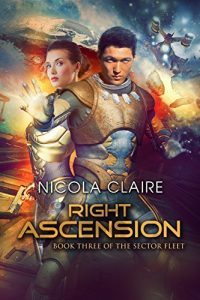 Right Ascension by Nicole Claire:
Right Ascension by Nicole Claire:
“This is Captain Anderson. Brace. Brace. Brace.”
Sophia Anderson has a heritage she should be proud of, but to those onboard the AUS Corvus, she’s not earned her position like the rest of them.
Every day she has to prove herself to the Anderson Universal crew onboard her ship. And then the worst thing happens.
The captain is killed in battle and Sophia, as First Officer, must take his place.
Teaming up with the unflappable Lieutenant Commander Leo Sait?, Sophia finds her footing onboard the beleaguered vessel as well as something much more precious.
Intimacy and destiny align amongst the planets and stars, but can the chief science officer and captain overcome the pressures of command when falling in love and still save their fleet?
And can any of them hope to survive the treacherous voyage to New Earth unscathed?
When humanity reaches for the stars in a race for survival, only the most daring amongst them will succeed.
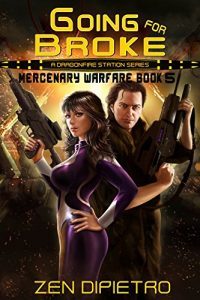 Going for Broke by Zen DiPietro:
Going for Broke by Zen DiPietro:
There’s no place like home.
Cabot’s adventures have brought him all the way around to his home planet.
Ditnya Caine has turned on the PAC, even as it continues to battle the Barony Coalition.
At least Cabot’s on a familiar battleground.
He’ll dig up some old connections and forge some new ones to figure out what Ditnya and Barony are plotting. In the process, he’ll even have to deal with some personal unfinished business.
They say you can never go home, but Cabot’s about to prove them wrong.
This book concludes the Mercenary Warfare series, but fear not—Cabot, Nagali, and Omar will continue in the overarching Dragonfire Station series. It’s always a good day to be a trader.
“Love…can destroy, it can build, or it can do both at once…”
With the Papilion’s whereabouts unknown, the Shadow pursues its plan for Marathana’s destruction. In control of the Northern tribes and strengthened by allies in the Deep Southernlands, the Shadow prepares to unleash its ultimate weapon, the berserker.
Jeru’s sudden reappearance reveals the presence of a powerful, new will at work. Blessed by the Lightbearer and supported by a ragtag group of survivors and unexpected allies, Jeru prepares to lead the small army into enemy territory.
As war breaks, Kelen and Jeru clash one last time. One brother seeks to destroy, the other to save. The strongest will prevail, sealing Marathana’s ultimate fate.
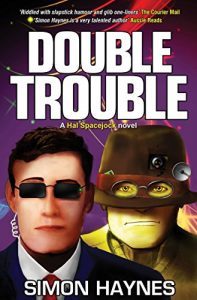 Hal Spacejock 8: Double Trouble by Simon Haynes:
Hal Spacejock 8: Double Trouble by Simon Haynes:
Hal Spacejock dons a flash suit, hypershades and a curly earpiece for a stint as a secret agent, while Clunk is invited to a ‘unique business opportunity’ by a pair of rusted friends.
Inevitably, things turn sour, and it’s all hands to the pumps as the good ship Spacejock springs leaks from stem to stern.
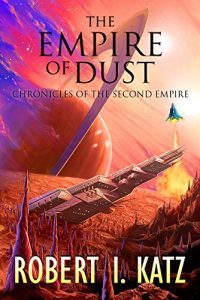 The Empire of Dust by Robert I. Katz:
The Empire of Dust by Robert I. Katz:
Michael Glover survived every mission the Empire assigned him and then he survived the revolution that ended it all.
But can he survive when everything he knew and held dear has vanished into the past?
Awakened after 2000 years to find a new Empire rising to replace the old, Michael is given a second chance to make a difference. Can he take advantage of that chance? Does he even want to?
Trouble is brewing among the stars. Ships are vanishing. Military bases are being attacked. Chaos is spreading. Is this random piracy or a wide-spread conspiracy?
Naval intelligence is desperate to find out and Michael Glover, a soldier without a country, a man thought dead for over 2000 years, reluctantly decides that he cannot stand by when duty calls.
It’s a new Empire but the same old mission, and Michael Glover, deep in his soul, is still a soldier who can be counted on.
But Michael Glover has an independent streak. He’ll carry out the mission but he’ going to do it in his own inimitable way, whether naval intelligence likes it or not.
 Gods and Demons by B.R. Kingsolver:
Gods and Demons by B.R. Kingsolver:
Life’s tough as an Elf girl stranded in Earth’s realm. Humans don’t believe in Elves or magic, so I try to stay low key.
Then a jaguar shifter drops in out of nowhere and tells me about an ancient blood-magic statuette, powerful enough to blow holes in reality. She needs an Elf to track it down, and I’m the only Elf available.
But every blood mage in the world also wants it. Enter stalker werewolves in a black Mercedes, a master magician leaving a calling card on my door, and demons every time I turn around. It wouldn’t be so bad, but some of them are really rude.
Time for a lesson in manners.
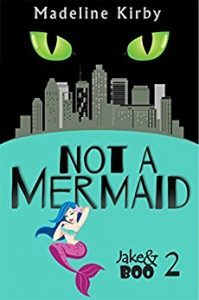 Not a Mermaid by Madeline Kirby:
Not a Mermaid by Madeline Kirby:
It’s July in Houston, and when heat waves and storm warnings finally give way to flooding rains, Jake Hillebrand’s strange dreams take a sinister turn. When the flood waters recede, the body of a young woman is found on the banks of Buffalo Bayou – a young woman whose life overlaps with that of Detective Victoria Perez.
With Perez on the sidelines, maybe she and Jake can finally come to an understanding. Or not.
Petreski’s working with a new partner, Jake’s declared a major, Jennifer Katz is moving on with her life, and Don has no idea that the new cat hanging around his apartment is not what she appears.
Contains even more carbs than “Not a Werewolf”, plus all you can eat shrimp!
[image error] Dragon Lost by Lisa Manifold:
I’m Aodan. A thief. A really good thief.
My best friend Margrite and I are nearly out of this crappy city. With this last job, we’ll have enough to disappear on an island somewhere. We’re so close I can practically smell the rum drinks.
But then all hell breaks loose when I wake up as a dragon. You know, teeth, claws, blue scales, furniture exploding under my massive form. The feeling of smoke is a permanent fixture in my throat. The dragon appears when it wants to, and I black out.
I don’t have time for this.
To add to all this drama, I think someone is trying to kill me. My home is gone. I have nowhere to hide while I sleep off the crazy dragon hangover that comes after each appearance of the beast. As if the dragon scales weren’t enough, I’m now plagued by this new voice in my head – some annoying guy wanting to talk, and meet, and who knows what else? All I want is for me and my best friend to get out of town alive.
If I could stop sprouting a tail at inappropriate times, that would be pretty great too.
Dragon Lost is the first book in the Dragon Thief series.
Ethan still doesn’t know what happened to his missing brother four months ago. No idea where he went, who took him, or where to find the answers. But then he discovers Fizz, a mutant whose acid spit can melt off a man’s face, and he has a new lead.
Meanwhile, Carlo Martelli is in a rage. His cousin’s murder can only be a threat to his rule in the local mafia. The immediate suspect is the traitorous Michael Bello who ratted him out to the police. As the mob war erupts, Fuse finds himself in the cross-hairs, which may have been a trap for him all along.
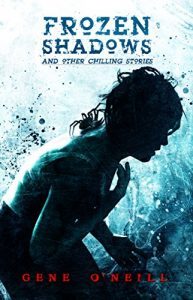 Frozen Shadows And Other Chilling Stories by Gene O’Neill:
Frozen Shadows And Other Chilling Stories by Gene O’Neill:
Hitch a ride with the master of setting as he blends and bends genres with science-rich, thought-provoking short stories. “Buy the ticket, take the ride.”
“A maestro of the field, Gene O’Neill’s stories are consistently well-executed. He writes with authority, depth, and loads of worldly and writerly experience, and delivers fascinating stuff.” – Darren Speegle
Along the way you will travel to the top of Mt. George, up and down Napa Valley, through Sacramento, and into the heart of the Bay Area, to the ‘Loin in San Francisco, Hotel Reo, Chapel of the Chimes, the back streets of Oakland, and other familiar dark places. The stories explore quantum entanglement, Visual Migraine Events, electro-shock treatment, Obsessive-Compulsive Disorder, and Tourette’s syndrome experimentally treated with Temporary Deep Brain Stimulation. And as you read you may start to notice all these stories are connected in a way.
Includes:
“Frozen Shadows” – Coming of age autobiographical
“The Algernon Effect” – A transgressive love story
“Transformations at the Inn of the Golden Pheasant” – A damaged vet describes a bizarre transformation
“On the Right Side of the Road” – An ex-con suffering from Visual Migraine Effects may just save the world
“Black Tar/Red Alien” – A heroin addict’s confrontation with a horrific alien
“Broken Lady” – An aging singer pays a terrible price for defending herself during a rape
“The Shaking Man” – An ex-con receives an experimental treatment for his Tourette’s Syndrome with unexpected results
“3-Dot People” – An amnesiac man drops literally into the Tenderloin of San Francisco
“A Faint Scent of Musky Lime” – A fan of the writer Tom Really finds himself experiencing one of Reamy’s horrific stories
“At the Lazy K” – A historic epic of a ghost plaguing a rehab clinic on an old ranch
Seeing into a soul is easy for Flint.
She can change a life or even the world with her words.
She should have kept her mouth shut.
Flint thought that having six older brothers and growing up in a dangerous frontier town would prepare her for anything. She soon discovers that the world is a lot more complex than she expected, and it’s going to take more than a strong back and good intentions to achieve her goals.
When it comes to magic, all the wishes in the world won’t change who you really are. And sometimes that’s okay.
 300 Degree Days and Other Stories by Deborah Sheldon:
300 Degree Days and Other Stories by Deborah Sheldon:
‘Sheldon’s stories lift the skin of small, suburban lives to expose the raw nerves beneath. Her writing is intimate, compelling and alarming…’ – The Short Review, UK.
Sometimes, the ties that bind are sharp enough to cut. In these eleven stories, set in contemporary Australian suburbia, Deborah Sheldon examines the darker side of family relationships. Unsettling and incisively written, each story of betrayal, envy, loss or bad blood resonates for a long time after reading.
[image error] Pursuit by Val St. Crowe:
The war between the humans and the aliens is over. The humans lost.
Gunner Jisse captains the Star Swallow, a ship that takes whatever job it can, from running guns for the Resistance to smuggling food to hidden human outposts. If the aliens discover what he’s doing, he and his crew are dead.
Eve Harlowe sees visions. She’s always known her future is to be the mother of a champion, who will finally defeat the aliens and set humans free. The first step toward her fate is setting foot on Gunner’s ship. He’s destined to be the father of this champion.
Gunner’s not interested in any of that. He thinks seeing the future is hogwash until Eve sees an attack that comes to bloody fruition. If it weren’t for annoyances like busted rescav thrusters and firefights in space, he’d have gotten Eve off his ship already.
Because the aliens have visions as well, and they’ve identified Eve as a threat. The aliens will chase her to the dark corners of the galaxy with one goal. Destroy.
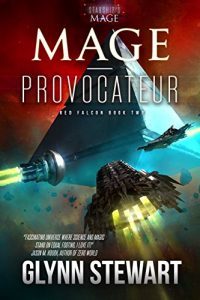 Mage Provocateur by Glynn Stewart:
Mage Provocateur by Glynn Stewart:
Vengeance hunts them.
Rebellion seeks them.
Loyalty commands them.
The shadows will fear them.
Captain David Rice and Mage Maria Soprano have made their choice, signing up with the Martian Interstellar Security Agency and converting Red Falcon into a covert operations ship for the Protectorate.
Their new duties drag them back into the very underworld they once strove to escape, intentionally provoking the Azure Legacy into a renewed conflict. They find unexpected allies with secret agents from Legatus’s rebellion against Mars as they seek to stop Mikhail Azure’s Blue Star Syndicate from being reborn.
The Azure Legacy wants revenge. Legatus wants blood. David and Maria are bound by the overriding duty of all officers of the Mage-King’s Protectorate:
Protect the innocent.
Jon Bartlett’s path is clear before him: finish his last year of schooling, then off on the family’s ships to learn the intricacies of interstellar trade. But a message of tragedy at home comes for him, and his expected life is flung far out of reach and he’s cast into a role he never wanted.
A portion of Spacer was previously published as the short story Wronged, by J.A. Sutherland
[image error] The Promise of a Battered Moon by Jack Teng:
A planet-killer asteroid is hurtling to Earth and everyone is freaking out. But not Manon Fontaine. She knows what the asteroid really is and it’s hers. Once she controls it, she’ll revive the world’s post-war economy and also her mother’s mining company. But first, she needs to navigate family betrayals and kidnapping attempts before she can finally determine her own fate.
Meanwhile, Ann Wilson, an augmented Union super-soldier, has been having problems (beyond the mental strains of indiscriminate killing): her last targets were blown up with fractional deuterium devices, and made things very messy. Ann hates messes. What she hates more is a commanding officer who jerks her around and then sends her, of all places, to Luna City. Little does she know she’s conducting illegal missions to gain control of the asteroid.
In the middle of it all, is Eric Lin, a Union-born-Chinese thruster mechanic. Because of the war with the PPA, he’s been ostracized and forced off-planet to Luna City and the orbital colonies. All he wants is to be accepted and left in peace. This apparently is too much to ask, as both the Union and the PPA send soldiers to drag him away for the-hell-knows what. The reason is in fact that he holds the key to controlling the asteroid.
Amidst traitorous double-agents and assassinations, Manon, Ann and Eric’s paths collide, leaving a wake of destroyed orbital stations and rampaging mobs, ultimately leading them into a confrontation on the moon.
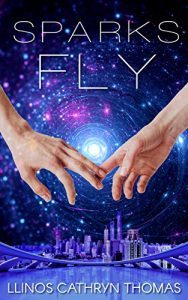 Sparks Fly by Llinos Cathryn Thomas:
Sparks Fly by Llinos Cathryn Thomas:
After twenty-five years of single-minded determination, Marianne Gordon has finally achieved her ambition and been promoted to Principal of the Vesper School for Zero-Gravity Artistic Display.
But her moment of triumph is cut short when she discovers that she must share her position with Josephine Knight, a celebrated zero-gravity performer who doesn’t know the first thing about teaching. Deeply insulted, Marianne does her best to carry on as though Jo isn’t there, but Jo has a way of making her presence felt.
When the future of Marianne’s beloved school is threatened, Jo may be the only person who can help – but only if Marianne can learn to let her in.
[image error] Nepenthe Rising by John Triptych:
In the far future, two major factions are locked in a galactic cold war. As tensions mount between the technocratic Union and the genome-harnessing Concordance, both sides anxiously watch for a chance to conquer the other.
The Nepenthe is a pirate vessel, loyal to neither. Led by the enigmatic Captain Dangard, her rough and ready crew includes the cat-like alien Commander Creull, Zeno the immortal synthetic, the dashing Garrett Strand, and Duncan Hauk, a promising young recruit.
Hired by a cryptic employer, the crew waylays a transport ship carrying a mysterious passenger. In due time, this incident sparks the beginnings of an interstellar conflict that could threaten the state of known space.
The first of an epic new sci-fi series, Nepenthe Rising delivers what today’s fans want: detailed world-building, thrilling action, and mind-blowing adventure on a grand scale.
[image error] Dustrunner by Dean F. Wilson:
Nox is a wanted man.
While searching for a criminal, the fabled Coilhunter wanders into a tribal village massacre. He didn’t do it, but that doesn’t matter. The clues point to him, and he’s made a lot of enemies over the years. Many would happily see the tables turned.
His pleas of innocence fall on deaf ears. No sooner does he try to find the real killers than posters go up across the Wild North—posters with his face and his name. He isn’t the only bounty hunter out there. Dozens assemble to cash him in.
Tasked with finding out who’s framed him, Nox must also survive the constant onslaught of frontier law. He’s used to hunting others. He’s not so used to life on the run.
This is a standalone book in the Coilhunter Chronicles series, which can be read in any order.
 Send to Kindle
Send to Kindle
March 29, 2018
Indie Crime Fiction of the Month for March 2018
 Welcome to the latest edition of “Indie Crime Fiction of the Month”.
Welcome to the latest edition of “Indie Crime Fiction of the Month”.
So what is “Indie Crime Fiction of the Month”? It’s a round-up of speculative fiction by indie authors newly published this month, though some February books I missed the last time around snuck in as well. The books are arranged in alphabetical order by author. So far, most links only go to Amazon.com, though I may add other retailers for future editions.
Our new releases cover the broad spectrum of crime fiction. We have cozy mysteries, small town mysteries, paranormal mysteries, historical mysteries, WWII mysteries, British mysteries, humorous mysteries, crime thrillers, psychological thrillers, domestic thrillers, romantic suspense, sea adventures, spy fiction, hot FBI agents, reformed thieves, stalkers, serial killers, superheroes, spies, doofus detectives, intrepid reporters, crime-busting librarians, innocents accused and much more.
Don’t forget that Indie Crime Fiction of the Month is also crossposted to the Indie Crime Scene, a group blog which features new release spotlights, guest posts, interviews and link round-ups regarding all things crime fiction several times per week.
As always, I know the authors at least vaguely, but I haven’t read all of the books, so Caveat emptor.
And now on to the books without further ado:
 Darke Accused by Parker Avrile:
Darke Accused by Parker Avrile:
An FBI agent goes undercover to catch a thief who turns out to be too hot to handle.
Darke Davis destroyed evidence to give his partner-in-crime time to flee with thirty-nine million dollars— and Special Agent Flare Greene is determined to get that money back. Hooking up with Darke at a popular gay roadhouse seems like a brilliant way to insinuate his way into Darke’s life.
Flare didn’t plan on the two of them stumbling over a body and finding themselves on the run from charges of first-degree murder. It’s the perfect opportunity to bond with Darke, but if they can’t work together to solve these crimes, they may find themselves locked up together for longer than just one night.
No cliffhangers, and you may expect the killer to find justice. However, because Darke and Flare are at the beginning of their journey together, they reach a happy for now ending with relationship challenges remaining ahead of them.
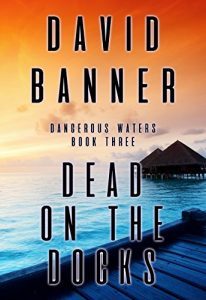 Dead On The Docks by David Banner:
Dead On The Docks by David Banner:
Brandon Waters was never expecting everything to go as planned, but he never imagined it would go this far off the rails…
After receiving a phone call from a new client he finds himself in St. Augustine, Florida ready to go to work. But right from the start, this is no ordinary case and it isn’t long until he finds himself caught up in the underground world of organized fight clubs and twisted millionaires.
With an seemingly innocent woman’s freedom on the line and a rogue FBI agent at his side he must try to find the truth in the lies and help uncover what really happened to his former best friend’s father. Were the police right, was the woman in jail really guilty of the crime or was there more to the case?
Dead on The Docks is the highly anticipated third installment of the hugely popular Dangerous Waters series.
 Her Sister’s Secrets by V.J. Chambers:
Her Sister’s Secrets by V.J. Chambers:
An anonymous letter summons Emilia Farrow to Siesta Key. An oceanfront house has been rented there for her, its closet stocked with designer clothes in her size. The mysterious correspondent promises that if she comes, she will find out what really happened to her sister Violet.
Her death wasn’t an accident.
Immersing herself in a world of wealth and privilege, Emilia has nightmares about the Wainwright mansion next door. Her mother used to work there years ago. Recently, her sister also worked for the Wainwrights. Just looking at the house makes Emilia feel as if she can’t breathe. Her strongest memory of the place is her mother packing up her and her sister and fleeing in the hours before dawn.
What happened all those years ago? Was Violet murdered? Who killed her? And who rented this house for Emilia?
Smuggling. Prostitution. Murder.
London. 1920 and coroner’s officer May Keaps is tasked with solving the mystery that surrounds the death of a young boy, found drowned in The Thames.
But was it murder or an accident?
May knows that when children go missing, the reason is often linked to money but she is in danger of underestimating the corrupting influence of power . . .
On streets where poverty and exploitation walk hand-in-hand everyone has a price. And some are more valuable dead than alive. But who is pulling the strings?
May must journey into the dark underbelly of London to find the answers.
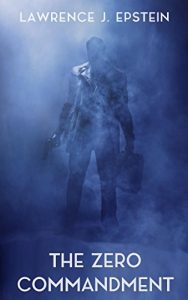 The Zero Commandment by Lawrence J. Epstein:
The Zero Commandment by Lawrence J. Epstein:
It is 1941. The country is on the edge of war. In New York, three men are murdered. The detective Charlie Singer is drawn into the case after rescuing a young woman being attacked in Central Park. With Katie Walker, his partner, Charlie deals with a famous gossip columnist, an organization devoted to fighting Hitler, and a violent group of haters. As Charlie uncovers the lies and secrets, he discovers a blossoming relationship with Katie who is undergoing a major life change.
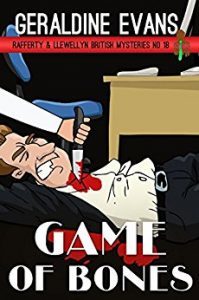 Games of Bones by Geraldine Evans:
Games of Bones by Geraldine Evans:
Sergeant Llewellyn’s remark that, perhaps, ‘Someone ELSE had made them a gift of Professor Anthony Babbington’ as the murderer, was just sour grapes, in Detective Joe Rafferty’s opinion.
But Llewellyn could plant a doubt where none had existed before. And Rafferty, sure in his own mind that they had the culprit, disregarded Llewellyn, who was known to greatly admire Babbington. They had so much proof it was embarrassing: Babbington’s fingerprints on the murder weapon; the victim’s blood on his shirt; and his DNA on the dead man.
Rafferty couldn’t believe it when his ‘sure thing’ began to slowly unravel. He refused to admit his growing doubts about Babbington’s guilt to Llewellyn, who championed the professor, and was as convinced of Babbington’s innocence as Rafferty was of his culpability.
But gradually, all Rafferty’s certainty vanished into dust, and he was left to prepare himself to face the music when Superintendent Bradley came back from his expensive holiday, to find that the ‘sure thing’ he had left with Rafferty, had inexplicably become anything but.
Unless Joe Rafferty could find some way to turn defeat into triumph…
[image error] Vic Boyo, Doofus Detective in Double Murders are Twice as Bad by Milo James Fowler:
Two murders. One detective. Half a brain.
1931, New York City: Detective Vic Boyo may not be the brightest bulb in the chandelier, but that doesn’t stop him from solving cases as only he can. With a little luck and a whole lot of gumption, Boyo sets out to find the murderer of a local cop. Problem is, Boyo’s more interested in a gorgeous femme fatale accused of killing her husband. She’s destined for the electric chair, but Boyo’s got a hunch she might be innocent. And nobody gets in the way of Boyo’s hunches, not even Vic Boyo himself.
When covert operations go wrong, the CIS sends in . . . The Corrector.
After a botched retrieval operation, Javin Pierce is sent in to complete the mission where others failed. But, before even getting started, Javin and his less-than-trusted partner, Claudia, must deal with a devious terrorist plot. Their search leads them to a flash drive containing scandals that could topple world governments and plunge Europe into absolute chaos if they do not retrieve it in time.
How will The Corrector fix this disastrous mission? Uncertain if they can even trust each other and unprepared for the shocking truth that could cost their lives, Javin and Claudia must stop the treasonous plot, retrieve the elusive drive, and save themselves and the entire European continent, all without leaving a trace . . .
 Not a Mermaid by Madeline Kirby:
Not a Mermaid by Madeline Kirby:
It’s July in Houston, and when heat waves and storm warnings finally give way to flooding rains, Jake Hillebrand’s strange dreams take a sinister turn. When the flood waters recede, the body of a young woman is found on the banks of Buffalo Bayou – a young woman whose life overlaps with that of Detective Victoria Perez.
With Perez on the sidelines, maybe she and Jake can finally come to an understanding. Or not.
Petreski’s working with a new partner, Jake’s declared a major, Jennifer Katz is moving on with her life, and Don has no idea that the new cat hanging around his apartment is not what she appears.
Contains even more carbs than “Not a Werewolf”, plus all you can eat shrimp!
[image error] Extra! Extra! Dead All About It by Amanda M. Lee:
The primary election is almost here and Avery Shaw is in her glory. Her boss has unleashed her on the leading candidates – including two of whom she downright loathes – and Macomb County’s leading reporter (and pot-stirrer extraordinaire) is about to turn the election on its ear.
She just needs to find a story first.
When her nemesis Tad Lancaster loses a volunteer, Avery sniffs out a bigger story … or at least she thinks she does. She has a pile of documents, too many insidious ideas to wrangle, and a long-suffering boyfriend who can do nothing but shake his head.
Avery is determined to find out the truth, even if it doesn’t lead to Lancaster’s downfall. She only has a limited time to do it, too, and the clock is ticking down to election day.
In short order, Avery has to uncover a pile of financial corruption, irritate her co-workers to the point where they don’t want to steal her story, hook her ex-boyfriend up with a new girlfriend, survive family dinner, convince her boyfriend she’s not chasing ghosts but rather something that’s really there, and save Macomb County’s election process for the people.
Oh, she also needs to figure out a way to avoid a baby shower, too.
It’s all in a day’s work for one hard-working and fast-talking reporter. She just needs to survive the final showdown to prove to everyone exactly how superior she really is.
 In Silence Sealed by J.R. Lindermuth:
In Silence Sealed by J.R. Lindermuth:
Lydia, daughter of Swatara Creek Police Chief Aaron Brubaker, is accused of murdering her boyfriend, Jason Russell, handsome but feckless stepson of Clay Stoneroad, a famous writer who recently moved to a farm outside town.
Daniel ‘Sticks’ Hetrick, now a county detective, is determined to prove Lydia’s innocence. His job is made more difficult when the weapon her father insisted she carry is found missing.
Mysteries surround the Stoneroad family. Vickie Walker, a strange young woman—also recently arrived in town—insists Nan Calder, the writer’s secretary, is her sister, a claim Calder denies. Then Diana Wozniak, reporter for a sleazy tabloid, is the victim of a hit-and-run accident, and police learn she attempted to blackmail the writer.
The sudden disappearance of Lydia and Vickie puts Hetrick and his friends in a desperate race against time to find them, unravel secrets, and apprehend the real killer.
Ethan still doesn’t know what happened to his missing brother four months ago. No idea where he went, who took him, or where to find the answers. But then he discovers Fizz, a mutant whose acid spit can melt off a man’s face, and he has a new lead.
Meanwhile, Carlo Martelli is in a rage. His cousin’s murder can only be a threat to his rule in the local mafia. The immediate suspect is the traitorous Michael Bello who ratted him out to the police. As the mob war erupts, Fuse finds himself in the cross-hairs, which may have been a trap for him all along.
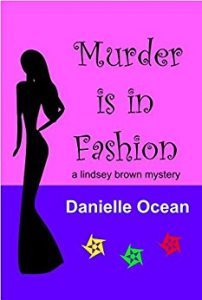 Murder is in Fashion by Danielle Ocean:
Murder is in Fashion by Danielle Ocean:
When Lindsey visits the site of the Fasha magazine photo shoot with her friend Jenna they expect to be dazzled by the spectacular clothes of the new edgy designer. What they don’t expect is to try to solve a murder. But then the stunning model, Dawn, is found murdered. The police decide to cancel the fashion show that was planned for that night at the same place for security reasons, unless the murderer is found. Lindsey decides to help out and try to find the killer before the show gets canceled.
This is the first novella in the Lindsey Brown mystery series.
For Megan Montaigne, library director, living in the top floor of the mansion-turned-library is a dream come true. At least it was, before the murders started.
Megan Montaigne has always secretly wanted to be a forensics investigator. The small-town library director has just begun rebuilding her life after tragedy tore it apart less than a year ago, and is happily settling into her new apartment on the top floor of the library by the river. But when a local celebrity turns up dead, the time has come to put her sleuthing fantasies into action. Has she unwittingly invited the murderer into her own home? And will she be able to prove her innocence before she becomes a victim herself?
By murder number five, Lennie is becoming more and more aware that these killings could have something to do with her.
The man she keeps seeing in inconspicuous places, doing natural-looking, everyday things appears to be anything but innocent to her as time goes on, but is she being silly and paranoid? Or is he really out to get her?
Lennie is forced to make changes to her life in order to keep her contacts safe but while the body count rises around her, a pattern seems to be emerging and Lennie is sure it must be only a matter of time before he kills again.
Tracking the stalker, when the police come up empty, brings its own consequences and it begins to look as though he’ll never be caught.
Will Lennie ever be free of him?
 Send to Kindle
Send to Kindle
March 18, 2018
New Two-Fisted Todd Adventure Available: Flesh Trade
Remember that I promised you that there would be more Two-Fisted Todd Adventures coming soon? Well, the next Two-Fisted Todd Adventure is finally here, albeit with some delay, because one of the vendors had problems getting new books up. Not to mention that I caught a nasty cold, which significantly impacted my writing, editing and blogging time.
Though Flesh Trade is the second Two-Fisted Todd Adventure published, it is actually the first one written. Because, as described in this post, approximately twelve years ago, I found some success selling short stories to a magazine that billed itself as a successor to the men’s adventure magazines of the 1960s.
Since I had hit upon a market that gave me steady sales, I also endeavoured to find out more about the actual men’s adventure magazines of the 1960s (about which I knew little aside from some lurid covers I found on the Internet). And so I also came across this art book which collects hundreds of covers of vintage men’s adventure magazines and also offers an overview about the genre, it’s development, prominent themes and subjects and what sort of content might be found inside those lurid covers. So I promptly bought the book.
The book also included interviews with artists, models and writers who had worked on these magazines. And one of the writers said that quite often, the covers were painted before there even a single story had been written. And afterwards, a writer would be commissioned to write a story to match the cover. And considering some of the really lurid illustrations on those covers – rugged men being attacked by all sorts of likely and unlikely wildlife, while buxom maidens were being tortured and menaced by evil Nazis, evil Communists, evil biker gangs and evil beatniks (the last one doesn’t quite fit) – coming up with a story to match must have been quite a challenge.
Now I have never been able to resist a writing challenge, so I decided to set myself the same challenge as those men’s adventure magazine writers of old, namely to write a story to match the cover of one of those magazines. So I opened the art book at random, picked one of the covers shown and decided to write a story based on it. The cover I picked was this one from the July 1960 issue of Man’s Life, by the way.
So I came up with a suitably rugged hero, freelance troubleshooter Todd Donovan a.k.a. Two-Fisted Todd, who is hired to find a bunch of American college students who have gone missing in the Caribbean, and sent him careening all over the island of San Ezequiel, punching suspects and taking names, all the while headed towards the scene depicted on the cover image I’d picked. The story eventually stalled out two thirds of the way through, so I set it aside. Then life got in the way and the magazine in question changed direction and became a sexy horror mag, depriving Two-Fisted Todd of his intended market (try as I might, I could not fit a sexy vampire into the story). Eventually, self-publishing became a thing, making previously unviable stories suddenly viable again. And through it all, Todd was biding his time in some tropical paradise, a cool drink in his hand, waiting for another job.
Todd’s moment finally came, when I dusted off the character for the 2017 July short story challenge and wrote what would eventually become The Crawling Death.
In the wake of editing and publishing The Crawling Death, I also took another look at the Two-Fisted Todd story I had abandoned years earlier. The story clearly needed some work, but I still liked it. And so I continued writing where I had originally left off and completed the story in a couple of days.
So here it finally is, more than ten years late: The very first Two-Fisted Todd story, which is now the second Two-Fisted Todd Adventure:
Flesh Trade
[image error]1966: Freelance troubleshooter Todd Donovan is hired to locate four American college students who have gone missing while doing humanitarian work on the Caribbean island of San Ezequiel.
While punching suspects and taking names, Todd learns that the college students as well as a young nun were kidnapped by a local crime boss named Cabeza.
So now Todd is engaged in a desperate race against time to rescue the kidnapped women before they can be sold to the highest bidder.
This is an adventure novelette of approx. 9800 words or 35 pages in the style of the men’s adventure pulps of the 1960s.
More information.
Length: 9800 words
List price: 2.99 USD, EUR or GBP
Buy it at Amazon US, Amazon UK, Amazon Germany, Amazon France, Amazon Netherlands, Amazon Spain, Amazon Italy, Amazon Canada, Amazon Australia, Amazon Brazil, Amazon Japan, Amazon India, Amazon Mexico, Kobo, Barnes & Noble, Apple iTunes, Google Play, Scribd, Smashwords, Inktera, Playster, Thalia, Weltbild, Hugendubel, Buecher.de, DriveThruFiction, Casa del Libro, e-Sentral, 24symbols and XinXii.
Will there eventually be more Two-Fisted Todd Adventures? I certainly wouldn’t rule it out, since they are fun to write. Plus, I have a whole book full of inspiration for more strange and deadly situations into which I can thrust poor Todd and watch him fight his way out.
But first, there are more In Love and War adventures coming, since I am currently about to finish the final proofread on the latest In Love and War story. After that, look forward to a new Hallowind Cove story, After the End 2 – More Stories of Life After the Apocalypse as well as Murder in the Family 2.
 Send to Kindle
Send to Kindle
March 5, 2018
Some Thoughts on the 2018 Oscars and their appreciation for SFF films
Yesterday was a day of decisions. Germany finally has a new (old) government after SPD members finally approved the coalition contract approximately half a year after the elections, the Swiss voted for keeping their TV license fee and Italy sadly voted for several equally horrible far right extremist parties. Oh yes, and the 2018 Oscars were also awarded last night. You can find a full list of the winners here, while Mike Glyer lists the winners of genre interest. And there were many this year, even though the Oscars are traditionally hostile to SFF films.
I probably wouldn’t have watched this year, because the TV in my office and the TV card in my laptop both ceased to work, after German antenna TV switched over to an entirely unnecessary HDTV format, which older TV’s and decoders can’t handle (plus, they charge you extra for the private channels in addition to the regular license fee). The livestream of German broadcaster ProSieben tends to crash my computer, which means that if I wanted to watch the Oscars, I would have to do so on the big satellite TV in the living room and couldn’t work on my PC on the side during the many, many ad breaks (though I worked on the proofread for the next In Love and War adventure). Considering the Oscars are almost four hours long, that’s a big time investment. It’s not an investment I would have made, if not for the fact that I actually cared about several of the nominated films this year, unlike many previous years, where the nominees were a lot of movies I hadn’t seen and usually didn’t care about.
But the Oscars have been slowly changing in recent years. Jimmy Kimmel’s jokes were pointed, but not under the belt like Seth MacFarlane’s infamous turn as Oscar host in 2013. Grisly Oscar baits such as propaganda-laden war movies, biographies of great men and the very occasional great woman, musicals that remind us why the musical is a largely dead genre and serious movies that contemplate the American navel are still nominated, but there are different nominees as well, the sort of nominees you wouldn’t have seen five, let alone ten years ago. And while American navels are still contemplated with alarming frequency, the navels at least aren’t always white, straight and middle class anymore. And occasionally, a genre film that’s not a musical or western also gets a look in. Two years ago, we had Mad Max: Fury Road takes home six Academy Awards in various technical categories and getting nominated for best picture as well (though it lost out to the forgettable Spotlight – so forgettable that two years later, I don’t even remember what it was about), last year the African American drama Moonlight beat the very white musical La La Land and this year, we had two SFF films – The Shape of Water and Get Out – nominated for best picture, best director, best screenplay as well as several acting awards. And unlike Mad Max: Fury Road in 2016, they actually got to take home Oscars in more than just the technical categories. This alone is reason to cheer.
The Shape of Water won a deserved four Oscars, including best picture, best director for Guillermo del Toro, best original score and best production design. Get Out and its director/writer Jordan Peele did not win best picture and best director and sadly, star Daniel Kaluuya lost out to Gary Oldman in a fat suit in the best actor category. However, Jordan Peele got to take home an Oscar for the best original screenplay, the first black person ever to win in that category. Blade Runner 2049 took home two Oscars for best cinematography (for Roger Deakins who won on his fourteenth nomination) and best special effects. Coincidentally, the special effects category is also the only category with a German winner, Gerd Nefzer (the other two German Oscar hopes, Hans Zimmer for music and Katja Benrath and Tobias Rosen in live action short film lost out, while Fatih Akin wasn’t even nominated for In the Fade). Nefzer is the second German to win an Oscar in the special effects category following Volker Engel from Bremerhaven, who won for Independence day in 1997. So much for “We can’t make science fiction and fantasy films and TV shows in Germany, cause we don’t have the technology”. Cause it turns out we do have the technical expertise – we’re just leaving it to Hollywood to actually do something with it.
Rounding out the Oscar winners of genre interest is the animated Disney/Pixar film Coco, which won in the best animated feature film and best original song category. Now I have to admit that I was rooting for other nominees in both categories. Loving Vincent was visually and technically a lot more interesting than the latest Disney/Pixar effort. And while the song from Coco wasn’t bad and the live performance with dancers dressed as Frida Kahlo was stunning, I still found it the least interesting of the nominated songs. I guess my favourite was Mary J. Blige’s song from Mudbound, though I also found the song from The Greatest Showman surprisingly good, given how bad the critical reception of that movie was.
Though the 2018 Oscars started out frustrating, when technical category after technical category went to Dunkirk or The Darkest Hour a.k.a. the two WWII pictures designed to make Brits and Americans feel good about themselves (at least they didn’t nominate the other two Churchill/Dunkirk films made in 2017 as well, thank heaven for small mercies). What was worse, that there were more interesting movies nominated and not nominated in both categories. I don’t even like Baby Driver, but you can’t say that its editing, sound editing and sound mixing aren’t a lot more interesting and novel than Dunkirk‘s. As for the best make-up category, the nominees this year were a movie about a disfigured child, at least as far as I could tell (I’ve never heard of the film, let alone seen it), and two historical films, where make-up basically meant making actors look like historical figures. And while making Gary Oldman look like Winston Churchill is at least something of a challenge, turning Judy Dench into Queen Victoria isn’t much of a stretch. Why no nominations for The Last Jedi, Guardians of the Galaxy (Groot and Rocket may be CGI, but Gamora, Drax, Yondu, Nebula, Mantis, Thanos and plenty of other characters are actors in make up), let alone The Shape of Water? Doug Jones does not really look like the Creature from the Black Lagoon, you know?
The Oscars in the acting categories predictably went to the sort of Oscar bait films that tend to win these awards. Frances McDormand and Sam Rockwell both got to take home Oscars in the best supporting actor and best actress in a leading role category respectively for Three Billboards Outside Whatever the Name of the Bloody Town Is (not the actual title, but I can never remember the name of the town and usually default to Dogshit, Nebraska). No idea why Sam Rockwell won – I expected either Richard Jenkins or Christopher Plummer to take it. As for Frances McDormand, I think she is a wonderful actress and I loved her acceptance speech, in which she asked all other female nominees in all categories to stand up and implored the powers that are in Hollywood to give all these women funding for their project. Nonetheless, I would have preferred both Sally Hawkins for The Shape of Water and Margot Robie for I, Tonya (zero interest in the film or the case, but even I can tell that her performance was exceptional) to Frances McDormand, because Three Billboards Outside Wherever is exactly the sort of contemplation of the American navel, even if contemplated by a British director, that I’m sick of. What is more, the American navels being contemplated are white, rural and presumably Trump voting navels that I really don’t care about.
Allison Janey won the Oscar for the best supporting actress for her role as Tonya Harding’s mother in I, Tonya. Her performance has been widely praised, so this is not exactly a surprise. Also not surprising is the best actor award for Gary Oldman for playing Winston Churchill in The Darkest Hour, since he was considered the frontrunner in this category, though my personal favourite was Daniel Kaluuya for Get Out. Not to mention that in spite of all the public proclamations of how Hollywood will and must change in the wake of #MeToo, Time’s Up and #OscarsSoWhite, awarding an Oscar to Gary Oldman (against whom there are allegations of domestic abuse) for his role in an old-fashioned bio-pic cum propaganda laden war movie sends a very different message. And for that matter, if Gary Oldman puts on a rubber suit and plays Winston Churchill, he promptly wins an Oscar. If Doug Jones puts on a rubber suit, in which he can’t even poop, to play an aquatic creature, he doesn’t even get a nomination, the only one of the major cast members of The Shape of Water who didn’t.
As might be expected, when a genre film wins Oscars in major categories such as best picture and best director, there is backlash, some of it from expected corners and some of it from unexpected corners. The expected backlash comes from established culture reporting and could be seen in cultural and news programs here in Germany calling this year’s Oscars “safe and unpolitical”, which makes we wonder if they’ve even watched the show, and dismissing The Shape of Water as a romantic fairytale, which makes me wonder if they’ve even watched the movie. Meanwhile, those same culture programs were falling all over each other to extoll the virtues of blatant Oscar bait like The Post (which didn’t win anything), The Darkest Hour (two wins) or The Phantom Thread (one well deserved win for best costume design) or European film darling The Square for best foreign language film (lost about to the highly deserving winner Un Mujer Fantastica, a Chilean film about a transwoman, whose star also got to present an Oscar). Interestingly, those programs did not extoll the virtues of Three Billboards Outside Wherever or Lady Bird, let alone Get Out. Well, at least no one has lamented that The Shape of Water winning best picture means the end of critical and serious cinema yet like they did after the best picture wins for The Silence of the Lambs, Return of the King or Chicago respectively. Okay, Chicago was something of a dud choice, but it was up against weak competition and there have been worse movies to win best picture.
The unexpected backlash against The Shape of Water comes from genre fans and critics, whom you’d think would be happy to see an SFF film take best picture. However, plenty of people are disappointed that the wrong genre film won best picture, because they were rooting for Get Out. Here is a polite version of this from Charles Pulliam-Moore at io9, who does like The Shape of Water, but would have vastly preferred Get Out and feels that The Shape of Water was the safe choice. I’ve seen uglier versions of this online, where people call The Shape of Water “that fish sex film” and declare that it won’t be remembered in ten years time, while Get Out will be considered a timeless classic. Personally, I suspect that both of them will still be well remembered in ten years time and that neither of them will turn out to be another Spotlight, forgotten after only two years.
Now I was very happy when Jordan Peele won in the best original screenplay category, was hoping Daniel Kaluuya would beat Gary Oldman in a fat suit to the best actor Oscar and would have been very happy for Get Out to win in the best director and best picture categories, too. I also suspect that Get Out got a lot of additional sympathy after it was reported that some older Academy members were flat out refusing to watch the film and dismissing it unseen, because they felt it was not Oscar worthy, since it was a horror film, B-movie like (uhm, what do they think inspired The Shape of Water?), released at the wrong time of the year and yes, had a black star in a non-approved “This is a very serious movie about racism and/or slavery” role. There were also the horribly racist comments by this anonymous Oscar voter about how Get Out “played the race card”, how she disliked Daniel Kaluuya, because he dared say something about racism in the US, while British, and how Octavia Spencer plays the same roles over and over again (well, I’m sure Octavia Spencer would love to play the Queen, Maggie Thatcher or the publisher of the Washington Post, too, but unfortunately black women still overwhelmingly get cast in stereotypical roles such as cleaners and maids). The racism on display here is horrible, if not entirely surprising. The Academy after all keeps giving Oscars to Clint Eastwood long after his heyday, nominated Sylvester Stallone but not Michael B. Jordan for Creed, snubbed Fatih Akin’s In the Fade, because white racist terrorists murdering muslims and a blonde white woman avenging the murder of her Kurdish husband and son are apparently too far-fetched for them (never mind that In the Fade is based on a real case, though without the vengeance angle), really loves WWII movies like Dunkirk or The Darkest Hour and felt that a fawning propaganda pic like American Sniper was Oscar worthy as late as 2015. Even if the make-up of the Academy of Motion Picture Art and Sciences is slowly changing and becoming more diverse, there are still a whole lot of old, overwhelmingly white and male lifetime members whose tastes are stuck sometimes in the 1950s. However, these people are not as strong as they used to be, otherwise we would have seen more wins for the likes of The Darkest Hour, Dunkirk, The Post or The Phantom Thread than we did. Even Three Billboards Outside Wherever is not the usual choice for those voters, since it has a British director, rural working class characters and a decidedly unladylike leading lady. The fact that Get Out and The Shape of Water or Moonlight last year or Mad Max: Fury Road two years ago even got as many nominations as they did, let alone that they won in several categories and not just the technical ones either is evidence of change.
Get Out and The Shape of Water are both very good films and I would have been happy to see either of them win, though I prefer the latter and was also very happy to see Guillermo del Toro’s work recognised, especially after Pan’s Labyrinth lost the best foreign language Oscar in 2007 to the horribly stereotyped Stasi drama The Lives of Others in one of the great mistaken decisions in Oscar history. And can’t we just be happy that there were two excellent genre films nominated for several Oscars this year and even won some of them (not to mention the nominations and wins for Blade Runner 2049 and Coco), without playing one against the other? Both Get Out and The Shape of Water would have been deserving winners. And let’s face it, even without the blatant racism of certain Academy members, Get Out winning best picture or best director was always a long shot. After all, it was Jordan Peele’s debut and debut films rarely win. Besides, even the nomination, let alone his win in the best screenplay category will open many doors for Jordan Peele. Not to mention that Jordan Peele and Get Out won the Independent Spirit Award in the best picture and best director category only a few days before. We will see more movies by Jordan Peele and we may see him win a best director Oscar in a couple of years. And while SFF films generally don’t have good chances of winning best picture in general, The Shape of Water with its retro setting, musical sequences and focus on the magic of cinema has more of a chance to appeal to more conservative Academy members than Get Out. Finally, I suspect that The Shape of Water also appealed more to non-American Academy members than Get Out, because in spite of its British star, Get Out is a very American film with a very American setting (suburbs are nowhere quite as stiffling and conformist and ready-made horror settings as in the US), playing on very American anxieties. The Shape of Water does have a very American setting as well and also plays into all sorts of men in black stereotypes, but I still feel that it’s appeal is more international.
As for people who claim that The Shape of Water was a safe and predictable choice, as this Guardian article says, The Shape of Water is anything but safe. It’s a movie by a Mexican director in which a group of marginalized people – a mute woman (sadly not played by a mute actress), a black woman and a gay man – go up against the military industrial complex to save a sentient non-human being from torture and vivisection. Like many of Guillermo del Toro’s films, The Shape of Water questions toxic masculinity, as this Twitter thread points out (highlights below – click through to read the whole thing):
but I believe there are two aspects to del Toro that lead to those charges: there is a shift in the way he tells some of his stories where he centers feelings, emotions and certain attitudes that are associated with femininity and they don't necessarily follow comic book arcs
— Flavia Dzodan (@redlightvoices) March 5, 2018
most of the men in power in del Toro's films (and I'd make an exception for Stacker Pentecost who's not really "in power" but leading which is a very different thing) are very toxic, harmful men. Metaphors of what toxic masculinity does to everyone who deviates from its rigidity
— Flavia Dzodan (@redlightvoices) March 5, 2018
and I do wonder if part of the hatred his films elicit is not based on that portrayal of toxic masculinity. A lot of white men who are into genre think of themselves as the outcast, not the toxic man in power
— Flavia Dzodan (@redlightvoices) March 5, 2018
The Shape of Water also feature female masturbation and – what apparently put off some people – a sex scene between Eliza and the acquatic creature. Honestly, the objection to the sex scene in The Shape of Water is the most baffling thing to me, but then certain people were also put off by the gay sex between a 17-year-old and a 25-year-old in Call Me By Your Name, even though the film is set in Italy, where the age of consent is 14 and 17-year-olds having consensual sex with 25-year-olds is completely unobjectional. As for The Shape of Water, first of all sex between a human woman and a sentient aquatic creature is no more bestiality than sex with werewolves, vampires, aliens, etc… And besides, critics have been remarking on the erotic undertones in the original Creature from the Black Lagoon since the movie came out in 1954. Hey, I wrote a short story in which a young woman has sex with the Creature from the Black Lagoon (with consequences) two and a half years ago (collected in Bug-Eyed Monsters and the Women Who Love Them), long before The Shape of Water came out. And I’m pretty sure that Guillermo del Toro and I are not the only people who’ve watched The Creature from the Black Lagoon and wondered, “What if the Creature did more than just watch her swim and carry her off? And what if it were consensual?”
So no, The Shape of Water was not the safe and predictable choice no more than Get Out or even Lady Bird (I have zero interest in a mother-daughter drama about Catholic schoolgirls, but that doesn’t mean it wouldn’t have been a deserving winner) would have been. Dunkirk or The Darkest Hour would have been safe choices (because apparently, umpteen WWII pictures, including four about the same aspect of it in the same year weren’t enough). The Post would have been a safe choice (stars Oscar darlings Meryl Streep and Tom Hanks and has something to say about censorship and freedom of the press, while being safely removed in time from what is happening now). The Phantom Thread would have been a safe choice (stars Oscar darling Daniel Day Lewis and has some very pretty dresses). The Shape of Water is not a safe choice and a very good film besides. So why can’t we celebrate both The Shape of Water and Get Out as two very good genre films with something to say who both got Oscar nods last night, even if the winner wasn’t ultimately the one we’d prefer?
 Send to Kindle
Send to Kindle
February 28, 2018
The Other Star Trek Show: Some Thoughts on The Orville
It seems to be one of those moments of cosmic serendipity, when two or more works with eerily similar concepts come out independently of each other at around the same time. Pop culture is full of such moments, such as when both the original Star Trek and Germany’s Raumpatrouille Orion premiered within two weeks of each other, albeit on different continents, in September 1966. Or 1991, the year of the two Robin Hood films (and the better one of the two is the one no one talks about anymore), 1997, the year of the two equally forgettable volcano films, or 1998, the year of the two “asteroid threatens Earth” films. 2017/2018 also had such a moment of cosmic serendipity, because it was not only the year that four different movies about Churchill and Dunkirk (why, dear gods, why?) and two different takes on the John Paul Getty III kidnapping (why? Who still cares about that?) came out, but also three very different takes on Star Trek, one official and two inofficial ones with the serial numbers filed off, after twelve years of no Star Trek on the small screen at all.
I have already exhaustively talked about Star Trek Discovery and also discussed Black Mirror‘s take on Star Trek, “USS Callister”. So that leaves the third version of Star Trek, Seth MacFarlane’s The Orville, which is the only of the three current variations on Star Trek that I haven’t yet seen. However, yesterday I rectified this and watched the first two episodes of The Orville.
Now the initial reception of The Orville was mixed, to say the least. Official TV critics were generally baffled, because they went in expecting a Star Trek parody with MacFarlane’s trademark crude humor and got something quite different. Meanwhile, reactions from SFF fans and reviewers ranged from “This feels like fanfiction and watching someone’s private Star Trek fantasy” via “This is kind of old-fashioned, like The Next Generation used to be twenty-five years ago and those who like the show are old-fashioned” and “Who cares if it’s official or not, at least it feels like Star Trek, unlike some other show you could name” to “Star Trek with the serial number filed off or not, this actually is a pretty good show.”
None of these reactions are wrong and all contain at least a kernel of truth. For starters, The Orville is not a Star Trek parody in the vein of Bully Herbig’s Traumschiff Surprise skits, Pigs in Space or even Galaxy Quest. And The Orville is indeed very different from Seth MacFarlane’s comedy work (which is a good thing, as far as I’m concerned, considering how dreadful my previous experience with Seth MacFarlane and his work was), though it does resort to typical US sitcom humor on occasion. Now some of the jokes – mostly those arising out of science fiction and Star Trek clichés, e.g. the jokes about the “anti-banana ray”, drinks on the bridge and cannabis from the replicator, Ed accidentally walking through the Blob like crewmember, the tentacled underwater creature which turns out to be a botanist or the bit with the Krill commander standing off center on the viewscreen (come on, it is weird that people always stand exactly in the middle of the viewscreen in SF films and TV shows, to the point that I even included a “Sorry, could you please adjust your screen” line in Graveyard Shift) – work. They work precisely because these jokes arise naturally out of the science fiction setting.
On the other hand, the typical US sitcom humor, particularly the bickering between Ed and his ex-wife Kelly or the brief scene with Ed and his very embarrassing parents, who insist on discussing their and Ed’s health issues, doesn’t work nearly as well, simply because it doesn’t really fit into the science fiction setting. Particularly in Star Trek like settings, audiences are used to the characters behaving with at least a modicum of professionality. I can’t imagine any Star Trek captain, not even Lorca, nor any captain in Star Wars, Babylon 5 or any other SF universe for that matter, yelling at their ex-partner in the ready room within earshot of the bridge crew or discussing colon cancer screenings via the bridge viewscreen. And while couples may quarrel and bicker, they usually quarrel because one of them is a surgically altered Klingon spy and not because they don’t like the way the other eats their morning cereal. Science fiction fans tend to like competentence porn and characters who know what they’re doing. US style sitcoms, on the other hand, derive their humor largely out of the fact that their characters, at least the male ones, are completely and utterly incompetent. And interestingly, The Orville sticks with the US sitcom trope of competent women paired with not very competent and occasionally childish men. Because aboard the Orville, the women (Kelly, Doctor Claire, Alara) and male aliens (Bortus, Isaac) are all pretty competent, while the human men (Ed, the helmsman and the navigator, whose names I have forgotten) are portrayed as the typical bumbling sitcom dudes, though the helmsman is also an ace pilot. What is more, Ed and Kelly are very much the typical US sitcom couple. She is highly competent and attractive, whereas he is very average and bumbling. And like so often with sitcom couples, you wonder just why a woman like Kelly would put up with a guy like Ed in the first place. And Kelly clearly does care about Ed, as the final moments of the first episode show, we just don’t know why. Maybe, The Orville will eventually answer that question, but for now it’s a mystery. Though several reviews I’ve seen have said that the arguments between Kelly and Ed settle down after a few episodes, which is a good thing. Indeed, my Mom said, “Oh please! We all know that they’ll eventually get back together, so can they just stop the bickering and get on with it.”
Now the pilot episode makes it pretty clear that the Orville and her crew are very average. The admiral played by Victor Garber even says as much to Ed. The Orville is not the flagship of the fleet like the Enterprise (either of them) or a cutting edge secret weapon like the Discovery, it’s just a midlevel ship crewed by the sort of people who would never make the cut to serve aboard the Enterprise and wouldn’t survive five minutes aboard the Discovery. Victor Garber’s character (maybe I should just call him Admiral Exposition) pretty much tells Ed that he’s nobody’s first choice to command this or any other ship – they simply have more ships than captains (I wonder why. High death rate, some kind of war we’re not told about, recruiting problems?). Isaac and Alara are explicitly introduced as affirmative action picks (I wonder how well that bit went down in the US), the helmsman is a screw-up who’s only hired because he’s a friend of Ed’s, Kelly is only there initially, because no other first officer is available, and Doctor Claire is there because she is needed. In regular Star Trek, you only see a ship like the Orville, when it runs into trouble and the Enterprise or the Discovery have to swoop in to save it or mop up the remains after the cosmic phenomenon of the week killed everybody on board. But not every ship can be the Enterprise, the Voyager or the Discovery and it’s a pleasant change to focus on a more average ship with a crew that’s not quite as hypercompetent, but still do their best. I just wish that they wouldn’t have stuck quite so much with US sitcom tropes and clichés.
Now let’s move on to the next complaint, namely that The Orville feels like fanfiction. This is absolutely correct, because The Orville indeed feels like fanfiction. In spite of some token effort to file off the serial numbers, it’s very clear that The Orville is basically a Star Trek show set in the Star Trek universe. Okay, so their Federation is called Union, their Klingons are called Krills (who even look a lot like the nu-Klingons from Discovery), but they have warp drives, holodecks and replicators. About the only Star Trek tech The Orville doesn’t have are transporters (and Ed and Kelly are kidnapped via a transporter in episode 2, it’s just not human tech). So yes, The Orville is a big budget Star Trek fan film. But that doesn’t make it bad.
In her post about The Orville, Star Trek Discovery and other new US TV shows, Abigail Nussbaum says that The Orville made her feel a bit embarrassed at watching someone else acting out what is clearly a private fantasy. I sympathise with this, because I’ve had the same feeling on occasion. The most blatant example was while watching a special episode of the German comedy program Neo Magazin Royale, which was billed as the revival of the popular German game show Wetten Dass?. Now Wetten Dass? is certainly ripe for parody, though I did find the choice to parody the show when it had been off the air for three years a bit odd. However, when I watched the special Wetten Dass? edition of Neo Magazin Royale, I quickly realised that this was not a parody at all, but an earnest attempt to revive the former ratings juggernaut and also Jan Böhmermann applying for the job of Wetten Dass? host. The episode culminated in Böhmermann, who’d lost a bet, coming on stage dressed up in a costume from the musical Cats, singing the song “Starlight Express” from the eponymous musical, while sitting in a bathtub full of mustard. The whole thing was just as weird and disturbing as it sounds (and available on YouTube here). And while I was sitting there openmouthed, staring at the TV, I suddenly realised that I was watching someone else acting out their private fantasy. Böhmermann clearly was a huge Wetten Dass? fan and always dreamed of hosting the show, he clearly loved musicals, particularly the big 1980s musicals Cats and Starlight Express, and obviously wanted to perform in one of them. And as for the tub full of mustard, I honestly don’t want to know.
Watching Jan Böhmermann singing “Starlight Express” in a tub full of mustard, while hosting Wetten Dass? made me feel deeply uncomfortable, because I felt as if I had intruded on someone else’s fantasy. Abigail Nussbaum apparently had a similar reaction to The Orville. But while it was obvious at some points that Seth MacFarlane was clearly having the time of his life (watch how he fires his phaser – he’s dreamed of this moment for years), I never felt the same discomfort as I felt at watching Jan Böhmermann singing “Starlight Express”. It’s probably because while I understand why someone would dream of commanding a Starfleet ship (is there anybody who has never dreamed of that?), I haven’t watched Wetten Dass? in years, don’t like Starlight Express and find Cats overrated and certainly have never dreamed of bathing in mustard. So Böhmermann acting out his private fantasies felt alien to me in a way that MacFarlane acting out his doesn’t.
So let’s move on to the next point, namely that The Orville is old-fashioned and feels like 1990s TV, which is usually paired with the observation that Star Trek Discovery is a lot more like modern prestige TV in style, tone and look. Again, this criticism is absolutely correct, because The Orville looks and feels very much like a 1990s Star Trek show. The ship is clean and brightly lit, a stark contrast to the overly dim lighting that afflicts pretty much every other space-based SF show out there (and coincidentally, my Mom very much appreciated the fact that The Orville is well lit, since she hates the dim lighting that is currently so en vogue). Planets look like office parks, university campuses and shopping malls. Uniforms are colour coded and actually include colours other than black, blue or grey. Episodes are self-contained and wrap up their plot in 45 minutes. And while the visual effects look better than 1990s Star Trek, they are also ropier than what you see in Star Trek Discovery or The Expanse. Compared to the latter two, The Orville indeed looks rather old-fashioned. However, that’s not necessarily a bad thing.
Now I have been pretty critical of this so-called “golden age of television” or “peak TV” and especially of its excesses before. Not every male character in a TV show has to be a complex anti-hero (which all too often translates into horrible person) like the protagonists of the various “quality TV” shows. Of course, Ed Mercer is something of an anti-hero, but he’s an anti-hero the way Homer Simpson is an anti-hero. He’s not a murderous psychopath like Walter White or Gabriel Lorca. However, SF TV has room for both Ed Mercer and Gabriel Lorca. And while serialised shows can be great, when well done, not every show has to be serialised. And indeed, I often prefer standalone episodic shows to serialised shows, because if you watch too many serialised shows at the same time, it’s easy to forget what happened, even with recaps at the beginning. And don’t even get me started on shows that are clearly created solely for binge watchers who will burn through an entire season in a single weekend. I’m not a binge watcher, I neither have the time nor the inclination, and most working adults I know are not binge watchers either. Viewers like me exist and we are many. Because even in this era of “peak TV”, there is room for shows which are a bit like TV shows were back in the 1980s and 1990s. Genres like crime dramas and medical dramas still have these “old-fashioned” shows. There is very little talk about them, but plenty of people watch them, myself included. SFF, however, has been dominated by heavily serialised and dimly lit “peak TV” era shows for years now. There is certainly room for something that looks and feels more like science fiction shows used to be before the so-called “golden age of television” came along and usurped everything else.
So let’s address the inevitable comparisons between The Orville and Star Trek Discovery (leaving aside “USS Callister” for the moment, which is its own beast and uses Star Trek-like visuals to make a point about toxic masculinity). And the comparisons really are inevitable, because on the one hand we have a show that is very much 1990s Star Trek with the serial numbers filed off, while on the other hand, we have a show that carries the official Star Trek label and is full of references to previous iterations of Star Trek and yet manages to neither look nor feel like Star Trek much of the time. Indeed, if you look at Star Trek Discovery and The Orville side by side, they couldn’t be more different. One is light (in every way up to the sets) and somewhat fluffy, the other is grimdark (also up to the sets). And yet, there are some surprising parallels between both shows that go beyond the fact that both share a common ancestor, the original Star Trek of the 1960s.
For starters, both shows feature a protagonist who is something of a screw-up given their last chance to redeem themselves. Of course, Ed Mercer is merely a man having a rough time after a difficult break-up who occasionally shows up drunk for duty, while Michael Burnham is literally the most hated person in Starfleet, even though she didn’t do most of the things she’s accused of. What is more, both Ed and Michael were once highly promising officers who screwed up due to unexpectedly losing someone important to them, Kelly and Philippa Geogiou respectively. And both characters find themselves face to face with the person they lost, though Ed only gets a repentant Kelly, while Michael gets an evil and genocidal Mirror Georgiou. Still, considering that Star Trek traditionally features hypercompetent characters, the fact that both current reiterations focus on screw-ups is notable. Though I’d argue that Michael actually is highly competent with occasional lapses in judgement, while Ed does not strike me as very competent even at the best of times.
There are other parallels as well between Star Trek Discovery and The Orville as well. Both shows include a gay couple in the main cast, which wouldn’t be remarkable in 2018, if not for the fact that Star Trek traditionally has a crappy track record on LGBT representation. The Nu-Klingons of Discovery and the Krills of The Orville look eerily similar to the point that I said, “Oh, shut up, Voq, or whatever your name is” when the Krill commander issued his demands. Both shows also give us alien nudity and bodyparts we did not particularly need to see in L’Rell breasts and Bortus’ butt. Both shows have extras without any lines in highly elaborate make-up standing or walking around in the background. The pilot episode of Star Trek Discovery and the second episode of The Orville both have a female officer in over her head ignoring direct orders and committing mutiny in order to save their captain, only that Alara gets a medal and Michael gets a life sentence. Okay, so Alara succeeds, while Michael doesn’t, but the discrepancy is still striking. Both shows have a cafeteria scene, where no one wants to sit with the ostracised outcast, in the early episodes, another thing which isn’t a classic Star Trek trope, though it is a very American trope, as I explain here. Captain Lorca has a Tribble on his desk, while Captain Mercer has a plush Kermit the Frog. Though I liked the bit that Ed introduced Kermit to Bortus as “a great leader I admire” (if Ed sees himself as Kermit, does that make Kelly Miss Piggy? Though Piggy always was a cracking good officer in Pigs in Space) and that Ed’s Kermit had a role to play in the plot, whereas Lorca’s Tribble never did anything, not even detect Klingon spies in disguise, which is something Tribbles are traditionally good at. Hell, both shows mention a tardigrade, an otherwise obscure micro-animal whose DNA eventually plays an important role in the plot. And when the elderly scientist dude mentioned tardigrade DNA in the pilot episode of The Orville, I pretty much jumped from my chair, very much to my Mom’s surprise. And in fact, the tardigrade reference is the strangest parallel between both shows, especially since you hardly ever heard about tardigrades until last fall. Was there by chance an article about tardigrades in a science journal recently that might have inspired their unusual popularity in contemporary Star Trek inspired SF? Or maybe it’s just one of those moments of cosmic serendipity striking again.
So let’s take a look at the plots. The big difference is of course that Star Trek Discovery is heavily serialised, as is currently en vogue, whereas The Orville is episodic. Star Trek Discovery is also addicted to surprise revelations and shocking twists (TM), many of which are not nearly as shocking and surprising as the writers seem to think. What is more, not all of Discovery‘s shocking twists are earned or even fit very well into the ongoing plot. Indeed, Discovery has fallen prey to a problem that afflicts many serialised shows. The constant need for shocking twists (TM) and revelations means that the overall plot ceases to make sense after a while. This is what happened to Lost, Prison Break, Heroes and many other serialised shows which started off strong and then went completely off the rails. However, beneath all the shocking twists (TM), a lot of Discovery‘s actual plots are old SF standbys, frequently borrowed from previous versions of Star Trek. Though to be fair, Star Trek has gone through most viable SF idea and many non-viable ones (“Spock’s Brain”, anybody?) in fifty-one years, so there is a high probability that any given plot of a given SF story, particularly one set in space, will bear similarities to a Star Trek episode.
In its first two episodes, The Orville also dishes up some very old SF tropes, namely rapid aging and the alien zoo where humans are treated as exhibits. Star Trek has done both before as early as the original series, which tackled rapid aging in “The Deadly Years” and humans as zoo exhibits in its original pilot “The Cage”, later revisited in “The Menagerie”. And Star Trek sure as hell didn’t invent those tropes either, in fact they probably go back to the golden age, if not further. But even if a trope is old, the true skill lies in the execution. And in both episodes, the solution to the problem posed by the plot, destruction of enemy spaceship via rapid aged redwood tree in “Old Wounds” and handing over a huge video library of reality TV episodes to the alien zookeepers in “Command Performance”, was genuinely clever and unexpected.
However, I don’t watch TV for the plots anyway, since I can usually predict how an episode will go, which drives my Mom crazy. No, what keeps me coming back week after week, episode after episode, are the characters. And characterisation is one aspect where Star Trek Discovery has a huge advantage, because – as I pointed out in my season one postmortem – the characters and their relationships were one of the few things that I really liked about Star Trek Discovery. Though Star Trek Discovery discarded too many of its characters and two of the best romantic relationships in all of Star Trek for the sake of cheap twists and emotional drama. It also had the problem that the bridge crew, though seen in almost every episode, were cool looking cyphers with barely any lines and zero personality.
Compared to Star Trek Discovery‘s complex and interesting characters, The Orville‘s characters come across as a lot flatter and one-dimensional. But then, I’ve only seen two episodes of The Orville so far and by the second episode of Star Trek Discovery, we hadn’t even met most of the main cast yet. What is more, even if the characters of The Orville are largely a collection of clichés and stereotypes – the well-meaning bumbler, the repentant ex-wife, the class clown, the inexperienced officer, the logical android, the stoic alien, the hypercompetent doctor – I nonetheless quickly got a handle on who these people are. In fact, I can remember the names of most of the characters except for the helmsman and the navigator after only two episodes, whereas I was still referring to Discovery characters as jerky scientist dude, cute doctor or rubberhead several episodes in. This isn’t limited to Discovery either – I couldn’t remember the names of most of the characters of Enterprise after three seasons. In fact, I only know for certain that the captain’s dog was called Porthos and would have to look up the names of the others. So for me to remember the names of most of The Orville‘s characters after only two episodes is quite remarkable. The Orville‘s characters might not be deep and complex – and in fact I cannot imagine The Orville even trying to tackle subjects like PTSD and sexual violence against men like Discovery did with the characters of Ash Tyler (okay, they blew it in the end, but at least they tried) – but they’re certainly distinctive.
What sets Discovery apart from all other Star Trek shows is its tight focus on a single character, namely Michael Burnham. We mainly see the other characters through Michael’s eyes. And in fact, some of the inconstant characterisation in Discovery – Stamets pretty much has a complete personality transplant and Saru becomes much more likable in the second half of the season – might be due to Michael’s view of these people changing.
The Orville, on the other hand, seems to be more of an ensemble show like Star Trek traditionally was, with different episodes focussing on different characters. The first episode introduced the cast, while the second focussed mainly on security officer Alara (whom I’d love to introduce to Discovery‘s Tilly, since I’m sure they’d get along just wonderfully). It’s time honoured approach and one that works, because it gives us the chance to get to know everybody and also gives every character a chance to shine. Besides, Discovery‘s tight focus on a single character really wouldn’t have worked with The Orville, because the focus would most likely have been on Ed. Considering Ed is played by creator, writer and showrunnr Seth MacFarlane, a too tight focus on his character would easily turn him into a Mary Sue. And though The Orville does feel a bit like fanfiction, Ed Mercer is not a Mary Sue.
One of the main problems with season one of Star Trek Discovery was its sheer inconsistency. Over the course of its short first season, Discovery seemed to be awkwardly patched together from about five very different shows, only some of which bore any resemblance to what we’ve come to expect of Star Trek. This lack of consistency contributed to the whiplash effect of Star Trek Discovery and was also mirrored by a lack of consistency behind the scenes, since Star Trek Discovery had about four dozen different producers, only some of which had any previous experience with Star Trek at all, and seemed to switch showrunners every other week or so. The result is an unholy mess.
Now it’s difficult to judge The Orville‘s consistency on the basis of only two episodes. Even Star Trek Discovery managed to be consistent for two episodes in a row, depending on which two you picked. However, according to the reviews I’ve seen, the overall tone of The Orville remains constant over the course of the first season. That’s also largely because The Orville is the vision of one person, Seth MacFarlane. You may not like MacFarlane’s idea of what Star Trek should be like, but at least The Orville is consistent and won’t give you whiplash like Discovery. What is more, MacFarlane has staffed his team with a lot of Star Trek veterans behind the camera (and in the case of Penny Johnson-Jerald in front of the camera as well), whereas at least half the people working on Discovery never worked on any Star Trek show and some of them never even seem to have seen a single episode of Star Trek.
Coicidentally my Mom, who watched both the original series and the various 1990s Star Trek series (she even watched Deep Space Nine all the way through, while I bailed, though she bailed on Enterprise halfway through season 3), enjoyed The Orville a lot more than I thought she would, especially since she dislikes sitcoms and any sort of comedy programs. And though she didn’t much care for some of the overly sitcom-like bits, she enjoyed the show overall, because The Orville feels like Star Trek used to be and my Mom likes Star Trek. She also appreciated the fact that episodes are self-contained and that the sets are well lit and that during space battles, it’s easy to see who’s shooting at whom. In fact, she liked The Orville a lot better than The Expanse, which we’re also watching at the moment (she hasn’t seen Discovery yet).
It seems to me as if Seth MacFarlane set out to make a 1990s Star Trek show with more jokes and that’s exactly what The Orville is. It looks and feels like a lost Trek show from the 1990s and that’s probably why I found it so enjoyable. Because to me Star Trek, particularly the various 1990s Star Trek shows, are very much comfort viewing. Back in the 1990s, a German TV station broadcast Star Trek – starting with Next Generation, then Deep Space Nine, Voyager and Enterprise and then looping back to the beginning again – every weekday afternoon after Baywatch. I was in university at the time and watched whenever I could. And if I couldn’t watch, I taped it. So I’ve seen pretty much every episode of Next Generation and Voyager (skipped the latter seasons of Deep Space Nine and Enterprise, because I didn’t much care for them), several more than once. Coincidentally, I’ve also seen a surprising amount of Baywatch, because it was on directly before Star Trek (and trust me, Baywatch was really, really bad). At the time, I said, “Other people watch daily soap operas. Star Trek is my soap opera, only that my soap has spaceships and aliens.”
The Orville gives me the same comforting feeling that watching Star Trek used to give me twenty years ago. I can’t really see it every reaching the heights that Next Generation and even Deep Space Nine and Voyager reached on occasion, but then no one could have predicted how good the show would eventually become during The Next Generation‘s first season either. But from what I’ve seen so far, The Orville very much feels like a midlevel episode of Next Generation or Voyager. And that’s perfectly okay. Sometimes, comfort food is what you want.
Star Trek Discovery, on the other hand, is a lot more ambitious. It wants to have a serialised arc, more action than we usually see in Star Trek (and better choreographed, too), more complex characters and a deeper focus on them, more interpersonal conflict. Discovery wants to make a point about morality in wartime (not exactly new, but Americans seem to need regular reassurance that they can engage in wars and still remain true to their ideals, historical evidence to the contrary), it wants to present the Klingon point of view and the mirror universe point of view, it wants to make a point about PTSD and sexual violence and male vulnerability, it wants to colour in the margins of the orginal series, it wants to show how the Federation got from the quasi-dystopia of Discovery to the quasi-utopia of the original series in only ten years and it wants to give its protagonist a redemption arc, too. However, in the process, Discovery bit off much more than it could chew. Most of the many things Discovery wants to do just plain don’t work, though you can occasionally see glimpses of the much better show that Discovery could be, which makes it so very frustrating to watch. Meanwhile, The Orville has much lower ambitions, but largely succeeds in what it’s trying to do.
So which is better, Star Trek Discovery or The Orville? It’s difficult to say, because both shows are so very different in tone and style and scope, even if they are both derived from the same root. And honestly, why can’t we have both? The Orville makes for enjoyable comfort viewing, but probably won’t ever be groundbreaking. Meanwhile, Star Trek Discovery has the potential to be a very good show, once it gets its shit together. Besides, we finally have a several space opera shows on the small screen again (Discovery, The Orville, The Expanse, Dark Matter) after many years of no TV space opera at all and that alone is plenty of reason to celebrate.
 Send to Kindle
Send to Kindle
February 27, 2018
Indie Speculative Fiction of the Month for February 2018
 It’s that time of the month again, time for “Indie Speculative Fiction of the Month”.
It’s that time of the month again, time for “Indie Speculative Fiction of the Month”.
So what is “Indie Speculative Fiction of the Month”? It’s a round-up of speculative fiction by indie authors newly published this month, though some January books I missed the last time around snuck in as well. The books are arranged in alphabetical order by author. So far, most links only go to Amazon.com, though I may add other retailers for future editions.
Once again, we have new releases covering the whole broad spectrum of speculative fiction. This month, we have epic fantasy, urban fantasy, YA fantasy, paranormal mystery, paranormal romance, space opera, military science fiction, science fantasy, Cyberpunk, dystopian fiction, post-apocalyptic fiction, post-apocalyptic romance, horror, weird fiction, slipstream, vampires, werewolves, dragons, magic schools, dream mages, spellships, time travel, cyborgs, alien attacks, missing scientists, mythic carnivals and much more.
Don’t forget that Indie Speculative Fiction of the Month is also crossposted to the Speculative Fiction Showcase, a group blog run by Jessica Rydill and myself, which features new release spotlights, guest posts, interviews and link round-ups regarding all things speculative fiction several times per week.
As always, I know the authors at least vaguely, but I haven’t read all of the books, so Caveat emptor.
And now on to the books without further ado:
 Scarab: Falling Through Time by Helen Allan:
Scarab: Falling Through Time by Helen Allan:
Ancient Mystery – Timeless Love
An Eternity as an immortal in slavery was not what she had in mind!
Desperate and alone, sixteen-year-old Megan uses a powerful and ancient talisman to escape modern-day life and make a new start in ancient Egypt. But powerful enemies lie in wait, seeking her destruction and the magical scarab necklace she wields.
Will an alliance with another immortal, the handsome and secretive Franklin, help keep her from harm long enough to learn the secrets of the scarab? – Or will he cause her to lose everything – including her heart.
This, the first in the Scarab trilogy, will hook you in and leave you gasping – a time-travel romance with mystery, adventure, murder and love.
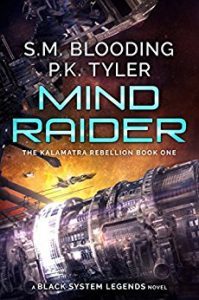 Mind Raider by S.M. Blooding and P.K. Tyler:
Mind Raider by S.M. Blooding and P.K. Tyler:
Keva Duste is an engineered human on a mission: find the weapon the corporate elite has amassed and secure it.
Humanity has conquered the black, but not their own inherent greed. The four systems surrounding Kalamatra Station provide members of the Elite class with everything they could want: mined minerals, abundant food, and an entire system to call their own, a place of paradise and riches. But for some, that isn’t enough.
Terrans and common spacers suffer under untenable work conditions and crumbling, radioactive stations while the Elite thrive. Now the commoners are threatening to revolt.
With the four systems on the verge of civil war, the Codex Syndicate’s covert intelligence network learns of an Elite weapon designed to alter the common people to their genetic core. The Elite have planned to test deployment on the mutinous Red Sky colony and force their compliance.
Codex Syndicate agent Keva Duste is an ex-military, engineered human with a score to settle. Together with a renegade space captain, an Elite refugee, and two sentient AIs, she must race to locate the weapon and stop the genocide of the human race before it can begin. Can Keva save Red Sky from destruction before the Elite turn this weapon on the rest of the settlements? And if she does, will she ignite a revolution?
A mission to a foreign land has left Captain Trip Yert with a responsibility he never anticipated: watching over two dozen magical stasis chambers containing half-dragon young, including eight that are half-human. As bewildering as he finds it, all of them are related to him.
He’s vowed to ensure they make it safely back to his homeland where the sorceress Sardelle can, he hopes, advise him on how to care for them. But while he, Rysha, and Major Kaika are investigating a friend’s death and trying to arrange passage home, someone steals one of the baby girls.
If Trip can’t deal with hostile mages, corrupt business moguls, and the surprising secrets of his mother’s past, he may lose the little sister he never had a chance to know.
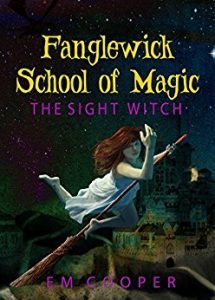 The Sight Witch by E.M. Cooper:
The Sight Witch by E.M. Cooper:
Marnie Speck has completed her first year at the Fanglewick School of Magic, but is waiting for the arrival of her witchy powers. When they fail to show, she is left wondering about the actual date of her birth and her true identity. After a tumultuous return to the Old World, Marnie and her best friend, Seb are welcomed to Mangleworm Avenue by Professor Lexi Spindlewood. Soon they discover life on Thundery Way, in the heart of Wandermere, is fraught with elfin and dragon dangers. Retreating to Fanglewick, they realise it too is under attack and unsafe.
Mage Mystilic ventures to Wandermere and leads Marnie and Seb on a wild dragon ride across a fantastic landscape to Morgansol in an attempt to trace Marnie’s parents’ final journey. To complicate life in the Old World, a new boy, the last apprentice at Blends and Fizzles, the potions and alchemy emporium, shows an unhealthy curiosity about Marnie and her newfound divination skills.
In a world forever changed by The Unveiling, where so-called “supernaturals” revealed their existence to humanity…
Katherine “Kat” King is on the run.
Two years ago, she woke up in a cell, held captive by a mysterious organization known as Advent 9. Subjected to harsh experiments involving magic, mayhem, and genetic engineering, Kat struggled to hold on to her sanity.
But now, she’s escaped Advent 9’s grasp—and she intends to keep it that way. Using the only three things that Advent 9 couldn’t take from her: an alias, amnesia, and an attitude that could make a grown man cry.
___
Liam Crown had it all once up a time.
A washed-up star detective with a penchant for “magic tricks,” Liam’s life fell to pieces when an accident cost him his family—and his sobriety. Now he scrapes by with a PI license and his late father’s used bookshop and spends most of his free time with a bottle in his hand.
But when a chance encounter with a strange woman makes him the target of a violent underground organization, Liam finds himself being dragged out of his stagnant life and back into the danger zone he thought he’d left forever.
And as the stakes begin to mount, Liam realizes that his old self is slowly coming back to life in the face of battle.
Now all he has to do is survive the war.
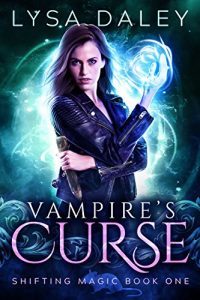 Vampire’s Curse by Lysa Daley:
Vampire’s Curse by Lysa Daley:
Lacey thought she’d escaped her dark magical past. She was wrong.
Lacey McCray has a secret. She isn’t just a grad student living in Los Angeles. She’s also a Class 2 Animagus or a witch who can shift into any animal she pleases. When her grad school scholarship mysteriously gets canceled, she receives a strange offer to work for a firm that specializes in collecting missing supernatural treasures. Desperate to make enough money to pay her tuition, Lacey agrees to give it a try.
After breaking into a troll’s lair to retrieve an enchanted necklace, Lacey starts to think that she’s a natural. And the money’s not half bad either
It doesn’t take long before she’s ruffled the feathers of one of the firm’s top agents named Stryker Smith. Oh, and then there’s the young human cop who keeps turning up wherever Lacey happens to be.
Just when Lacey thinks she’s made enough money to pay her rent and go back to being a full-time grad student, a rogue vampire threatens the life of someone she loves. Lacey McCray will find out just how good she actually is at this new supernatural job.
[image error] Spellship by Chris Fox:
The Last Dragonflight Holds the Key to Survival
Voria, Aran, and Nara survived their trip into the Umbral Depths. They retrieved the Talon, and are now searching for the First Spellship, the key to victory in their war against the Krox. Their search leads them to Virkonna, the home of the Last Dragonflight, a world where Dragons still rule. The world where Aran was born.
Aran’s past finally catches up with him, and he is forced to answer for killing Khalahk. The Wyrms demand he undergo a March of Honor, a brutal death march that few survive. Nara must not only accept Aran’s fate, but use it as a distraction to locate the First Spellship. Voria must forge an alliance with the ancient and very arrogant Wyrms of the Last Dragonflight, before the Krox do it first.
If even one of them fail, Krox will rise and the sector is doomed. Even success will carry a heavy price…
[image error] Night of Flames by J.J. Green:
A new world colony…
A moonless night…
An alien attack…
Ever wondered what it would be like to live on a starship? It was the only life Ethan knew.
When the colony starship Nova Fortuna reaches the end of its 184-year journey, most of its passengers have grown up aboard ship. They have no idea what it’s like to feel the wind on their faces or get wet in the rain.
On the first night of the new colony, Ethan is one of the lucky few who are sleeping planetside. Most of the others are Gens like Ethan, born and bred on the starship. A few are Woken, who were revived from cryonic suspension two years prior to Arrival.
The colonists settle down to sleep, but Ethan is restless. A strange noise disturbs him, and so begins the fight for his life, the lives of the settlers, and the colony itself.
Night of Flames is the prequel to the space colonization epic, Space Colony One.
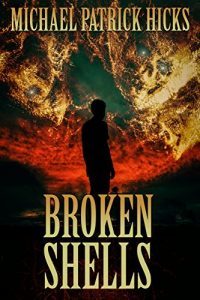 Broken Shells by Michael Patrick Hicks:
Broken Shells by Michael Patrick Hicks:
Antoine DeWitt is a man down on his luck. Broke and recently fired, he knows the winning Money Carlo ticket that has landed in his mailbox from a car dealership is nothing more than a scam. The promise of five thousand dollars, though, is too tantalizing to ignore.
Jon Dangle is a keeper of secrets, many of which are buried deep beneath his dealership. He works hard to keep them hidden, but occasionally sacrifices are required, sacrifices who are penniless, desperate, and who will not be missed. Sacrifices exactly like DeWitt.
When Antoine steps foot on Dangle’s car lot, it is with the hope of easy money. Instead, he finds himself trapped in a deep, dark hole, buried alive. If he is going to survive the nightmare ahead of him, if he has any chance of seeing his wife and child again, Antoine will have to do more than merely hope. He will have to fight his way back to the surface, and pray that Jon Dangle’s secrets do not kill him first.
 Blank Tapes, Volume 1: Weird and Dangerous Tales, edited by Paul Huxley:
Blank Tapes, Volume 1: Weird and Dangerous Tales, edited by Paul Huxley:
Blank tapes brings you nine stories from the fringes of reality. Challenging, thought provoking and just plain absurd, these stories are not your regular feel-good tales. It’s their job to worm their way into your thoughts and never leave. Bold new voices bring you disturbing insights from the further reaches of the possible. Just because you’re from around here doesn’t mean that you’re not alien.
Red Arrows by Anna Cotton: When Raymond goes for a haircut he isn’t the only one who’s going to come out with a new look.
Shark Girls by Dermot Jelfs: Thoughts on the true nature of dolphins and other concerns.
Down in the Dirt by L. Tucker: Meet Colin, your kid’s new best friend.
BLOCK parts 1-3 by Paul Huxley: The boy, the businessman, the doctor and the mother. Four lives irrevocably changed by the impossible.
I Don’t Believe in Ghosts by Damn Sung: There’s something strange in this house, but who are you going to call?
Filiarch by Gareth Pale: She always tips well, but this is the last time this pizza-boy is making the delivery.
Binky by Paul Huxley: He’s such a sweet little thing, unless his master is threatened.
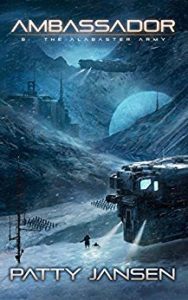 The Alabaster Army by Patty Jansen:
The Alabaster Army by Patty Jansen:
Deadly creatures, hostile climate, and that is just the scenery.
For many years, mysterious things have happened on the ice world of Tamer, but when a scientist goes missing from Barresh thought to be on Tamer, Cory is forced to take the issue by the horns.
Problem is, he is dealing with unexpected side effects of his fertility treatment, and, like his Coldi companions, he’s lost much of his night vision, and has trouble tolerating low temperatures.
Trouble is, a recent addition to his team has sent shockwaves through his group of loyal companions and things are still sorting themselves out.
Not his healthy self, under-resourced, frozen and half-blind, that’s not the best preparation to visit a world where humans are not at the top of the food chain, let alone dealing with enemies who will go to any lengths to hide their activities.
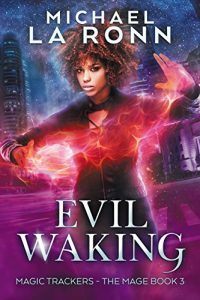 Evil Waking by Michael La Ronn:
Evil Waking by Michael La Ronn:
My last adventure made me famous. Now the fame might kill me.
Overnight, I became the city’s premier dream mage when I saved it from an evil demon.
My dream reading business has been booming ever since, but other dream mages in the city aren’t too happy about my sudden stardom.
Now I’m a target.
I’ve got to watch my back. And take it from me—the last person you want pissed at you is a dream mage.
Evil Waking is the gripping Book 3 in bestselling author Michael La Ronn’s Magic Trackers series.
[image error] Freaky Places by Amanda M. Lee:
Mystic Caravan Circus is heading to the West Coast, and while everyone is happy for the change of scenery there’s a pall settling over the group.
Poet and Kade are in a good place and planning for a change, but it’s something Poet can’t focus on because she feels as if someone is watching … and whoever it is has evil in his or her heart.
The festival location is different, and instead of space, the circus denizens have festival workers and artisans on every side. They’re open and exposed, and hiding their secret has never been more important.
When one of their own goes missing, Poet is determined to figure out exactly what’s going on. The answers won’t be easy, though, and there are all different types of evil.
A fight is coming, and the enemy is different from anything they’ve ever faced. They’re outnumbered and might find themselves outmaneuvered.
Who will survive? More importantly, who will be lost to something even worse than death? Sometimes death really is better.
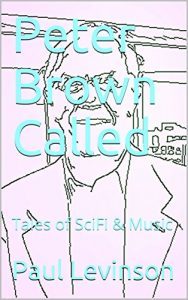 Peter Brown Called: Tales of SciFi and Music by Paul Levinson:
Peter Brown Called: Tales of SciFi and Music by Paul Levinson:
Writing science fiction and songs have been two of my lifelong passions. This anthology combines them, with a selection of my science fiction and fantasy stories that has music as a theme, and my lyrics that deal with far-off suns, robots, and time travel.
[image error] The Poison People by Alex Makepeace:
Are you one of them?
With a childhood full of secrets, Matt only wants to blend in. But when his university friends fall prey to a terrifying illness, he begins to realise how truly different, and dangerous, he really is. The disease spreads across the country and society disintegrates into fear and violence. The authorities are talking about terrorism, but Matt knows the truth, and it’s much, much worse. He goes on the run, joining others like him in their struggle to survive. But will it be at humanity’s expense?
With mind-bending scenes of transformation and a story charged with moral ambiguity, The Poison People is a Jekyll and Hyde for our times.
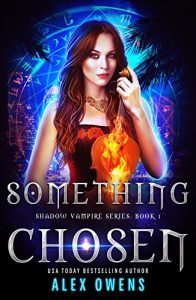 Something Chosen by Alex Owens:
Something Chosen by Alex Owens:
Death isn’t always the end… sometimes it’s only the beginning.
Claire’s trapped in a dead-end marriage, strapped for cash and getting desperate. Her chance at freedom comes in the form of a music con in Florida. Her mission? Win over a few big clients and collect a fat bonus check. It should have been easy, but Claire didn’t count on a bewitched violin, its sultry Italian owner, Bette, or her dark and dangerous companions.
Unfortunately, life isn’t all song lyrics and seduction. Tied to darkness by blood and power, Claire must harness her abilities if she has any hope of surviving this business trip from hell.
 Someone Else’s Wolf by Hollis Shiloh:
Someone Else’s Wolf by Hollis Shiloh:
Shane is a burned-out cop trying to mind his own business. Peter’s the new wolf at the precinct. Nerdy, awkward, and oddly attractive — and he seems strangely drawn to Shane.
Peter already has a partner on the job, the jealous and protective Sue. So, what’s the deal? Maybe he wants something else from Shane. Maybe his interest is purely personal…and not in the least professional. Shane’s starting to feel pretty unprofessional himself.
But having feelings for Peter is riskier than Shane could ever have guessed.
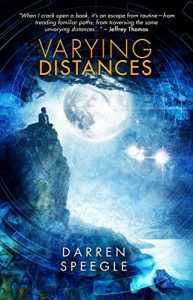 Varying Distances by Darren Speegle:
Varying Distances by Darren Speegle:
In his latest short story collection of dark, unsettling tales, Darren Speegle takes us on a journey through the textured layers of time and space. From Flower Age Ibiza, Spain to present-day war-torn Iraq, from the mysteries of America’s Deep South to those of a haunting future landscape where humans and machines are virtually indistinguishable, these stories explore what it is to be us among the varying distances.
An infamous German writer searches for the meaning of consciousness.
A future artist is forced by a cult leader to try to capture his soul in a portrait.
An American contractor working a camp gate in Iraq is confronted by incoming vehicles the likes of which he has never seen before.
A godlike being welcomes in Halloween with a special device.
A hitman tries to determine which woman among a party of three is the android, his target.
This surreal collection includes:
Introduction by Jeffrey Thomas
In the Distance, a Familiar Sound
The Flesh Winks While the Ghost Weeps
The Staging Yard
For Love of War
Balearic Moon
A Carousel of Faces
Death Paper Burn
Twinkle, Twinkle, Amsterdam
That’s the Game
Song in a Sundress
A Puddle in the Wilderness
Nowhere
A deadly virus. A brilliant, young researcher. And an infected survivor who threatens to steal her heart.
In a society ruled by sanctions and curfews, Dr. Meghan Forester emerges as the youngest and most promising scientist to join the fight against Makanza – the deadly virus that’s ravaged the world.
Inside Compound 26, a giant government-controlled research facility, Meghan’s new job involves studying the Kazzies, the rare survivors who carry the virus and now exhibit supernatural powers. But as her work enfolds, Meghan’s horrified at the brutal and unethical practices the Kazzies are subjected to. And most surprisingly, she falls in love with one.
Faced with growing conflict over helping the Kazzies versus following the Compound’s strict policies, Meghan must choose: obey the government’s unethical practices or risk everything to save the only man she’s ever loved.
Sergeant Jerry Harper recently caused an interstellar incident. As a result, tensions are high, and the Reliants of the Mentarchy have offered to host a conference to settle the matter peacefully. Jerry is ordered by his government to attend the talks and testify. He travels with the rest of the Agrarian diplomatic delegation to the planet Cortex, home of the Mentarch.
Cortex is supposed to be neutral ground, but that changes when an assassin targets the Agrarians. Jerry chases the shooter, but the pursuer quickly becomes the pursued, and he’s forced to go on the run. While Jerry’s wandering in the wilderness, the Mentarch activates its anti-gravity jammer, blockading space travel. The Agrarian delegates are now stuck on the planet, and Jerry is the only one in a position to do anything about it. He’s tasked with disabling the jammer.
Jerry has no idea how he’s going to do it, but he sets out anyway. Along the way, he starts to get a strange feeling about Cortex, some weird interaction between the planet and his psychic gift. He’s not sure what’s going on, but he suspects the Mentarch is up to something. Jerry must find a way to disable the jammer while also dealing with the Mentarch’s mind games. And if he wants to get his people off Cortex alive, he must do it before the place turns into a war zone.
New Bali is a swamp world located 20 light-years from Earth. Colonized by humans almost two hundred years before, the planet is also home to an intelligent, methane-breathing race of amphibians. The natives have a unique culture that precludes war and vengeance, but recent events have begun to unravel a once fragile peace.
Sophie Singh, heir to a vast conglomerate, must decide whether to retain her family’s control of Wetworld while Brother Moises Borbon, a conflicted Jesuit researcher, races against time to unlock the true meaning behind an alien art form that might be the key to truly understanding the natives.
These and many more unforgettable characters will experience critical choices ahead in the first part of this science fiction saga on colonialism, war, and sociopolitical upheaval.
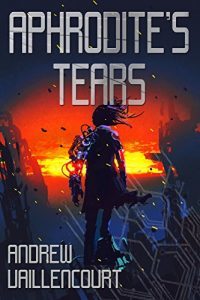 Aphrodite’s Tears by Andrew Vaillencourt
Aphrodite’s Tears by Andrew Vaillencourt
Roland Tankowicz hates Venus.
The last time he went there, he died. So, no one could really blame him if he never went back.
Nevertheless, when a squad of Venusian assassins ruins date night, everybody’s least-favorite Army-surplus cyborg decides to take a trip to Earth’s sister planet and have a sit-down with an infamous group of terrorists.
Perhaps it’s because he really likes date night. Maybe he just wants to keep the promise he once made to a troubled young man. It is even conceivable that he might still have a heap of unresolved issues with the separatists who blew his body apart years ago. For whatever reason, the big man and his motley crew of misfits strap on their guns and hurl themselves into the murky world of interplanetary terrorism.
To his dismay, Roland discovers that Venus has changed since his last visit. The black-and-white politics of the fanatics and governments he remembers have now merged into complicated shades of gray. Cyborg killers walk the halls without fear, and the soldiers stationed there seem no better than the thugs they fight. The sweltering underworld of Venus holds terrors and trials that will test the old soldier in ways he is not prepared for, while a crafty assassin stalks them all from shadows both real and imagined.
The team must to walk a narrow path between terrorists, soldiers, and their own dark pasts if they expect to get out of this one alive. Is The Fixer strong enough to pull an entire population from the ashes of civil war?
If he isn’t, they may all drown in a flood of:
APHRODITE’S TEARS.
[image error] Rune Legacy by Sandell Wall:
The emperor is dead, and the White City of Amalt has fallen. Those who defy Savaroth’s tyranny are enslaved, thrown into chains and forced to carry out his sinister designs. As Savaroth’s corruption claims the Alkomian empire, an ancient and terrible evil rises from the bowels of the earth. Rumors of a creeping, entangling horror sweep through the war-torn countryside. No soul is safe as man, woman, and child cower in the ruins of the once mighty empire.
From deep within a living forest, Aventine leads a fragile rebellion against Savaroth’s forces. Yet even as they seek to strike out against the tyrant, they are hunted by an eldritch monster that hounds their every step.
On the coast of the empire, Remus haunts the skies, harrying Savaroth’s forces with the might of the Black Citadel. Time is running out, and he must find a way to fight back or flee Alkomia forever.
Remus and Aventine are mankind’s last hope for survival. Together they will fall, or rise up and overcome the greatest threat the empire has ever known.
 Send to Kindle
Send to Kindle
February 26, 2018
Indie Crime Fiction of the Month for February 2018
 Welcome to the latest edition of “Indie Crime Fiction of the Month”.
Welcome to the latest edition of “Indie Crime Fiction of the Month”.
So what is “Indie Crime Fiction of the Month”? It’s a round-up of speculative fiction by indie authors newly published this month, though some January books I missed the last time around snuck in as well. The books are arranged in alphabetical order by author. So far, most links only go to Amazon.com, though I may add other retailers for future editions.
Our new releases cover the broad spectrum of crime fiction. We have cozy mysteries, small town mysteries, paranormal mysteries, historical mysteries, police procedurals, legal thrillers, crime thrillers, psychological thrillers, domestic thrillers, men’s adventure, missing girls, stolen women, lost memories, serial killers, vigilantes, lawyers, innocents on death row and much more.
Don’t forget that Indie Crime Fiction of the Month is also crossposted to the Indie Crime Scene, a group blog which features new release spotlights, guest posts, interviews and link round-ups regarding all things crime fiction several times per week.
As always, I know the authors at least vaguely, but I haven’t read all of the books, so Caveat emptor.
And now on to the books without further ado:
 Treachery on Tap by Constance Barker:
Treachery on Tap by Constance Barker:
Ghost Hunters on the Loose
The Grumpy Chicken Pub is infiltrated by a famous Ghost Hunting television show and our ghost chicken is not amused. When one of the ghost hunting crew ends up on the opposite side of the living, Ginger and her ragtag of misfits leap into action. Will the Grumpy Chicken ghost help solve the crime like before, or are there more ghosts to contend with?
Find out in this next installment of The Grumpy Chicken Irish Pub Series.
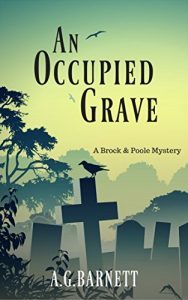 An Occupied Grave by A.G. Barnett:
An Occupied Grave by A.G. Barnett:
A village of secrets finds its past lies waiting…
When mourners gather in the village of Lower Gladdock, the grave is found to be already occupied. The victim is soon linked to a tragedy that tore the village apart five years ago and is handed over to the Bexford police to solve.
Detective-sergeant Guy Poole is hoping to put his traumatic past behind him and settle into his new station at Bexford. Now history is threatening to raise its head again, and he has a murder case to contend with.
Detective Inspector Sam Brock has a new recruit to take under his wing, and he’s determined this one isn’t going to die. As if that wasn’t enough of a headache, his wife is coming home and may be on the verge of discovering the lie he’s been telling her.
Newly paired duo Brock & Poole must track down the killer before more lives are lost.
 The Starlet and the Dead Duke by Bianca Blythe:
The Starlet and the Dead Duke by Bianca Blythe:
Murder. Manor homes. Malfunctioning chandeliers.
Hollywood starlets are supposed to be happily on set in sunny California, and not trapped in drafty manor houses during ferocious snowstorms.
But after Cora Clarke’s best friend and fellow actress elopes with an English earl, Cora visits England to help her friend brave the aristocratic disapproval of her new husband’s family.
Unfortunately the holiday turns nightmarish when a chandelier crashes down and kills somebody. When suspicion falls on her friend, Cora vows to figure out the identity of the murderer. After all, blizzards have a habit of preventing the police from arriving, and body counts have a dreadful habit of growing.
1966: Freelance troubleshooter Todd Donovan is hired to locate four American college students who have gone missing while doing humanitarian work on the Caribbean island of San Ezequiel.
While punching suspects and taking names, Todd learns that the college students as well as a young nun were kidnapped by a local crime boss named Cabeza.
So now Todd is engaged in a desperate race against time to rescue the kidnapped women before they can be sold to the highest bidder.
This is an adventure novelette of approx. 9800 words or 35 pages in the style of the men’s adventure pulps of the 1960s.
[image error] Tell Me I’m Wrong by Adam Croft:
What if you discovered your husband was a serial killer?
Megan Miller is an ordinary woman with a young family — until a shocking discovery shatters her perfect world.
When two young boys are brutally murdered in their tight-knit village community, Megan slowly begins to realise the signs all point to the lovable local primary school teacher — her husband.
But when she begins to delve deeper into her husband’s secret life, she makes discoveries that will make her question everything she knows — and make her fear for her young daughter’s life.
Facing an impossible decision, she is desperate to uncover the truth. But once you know something, it can’t be unknown. And the more she learns, the more she wishes she never knew anything at all…
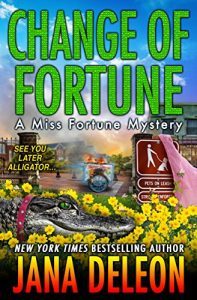 Change of Fortune by Jana DeLeon:
Change of Fortune by Jana DeLeon:
Sinful, Louisiana, is always a hotbed of activity, and despite the steamy heat, August is no exception. Godzilla is terrorizing the town, looking for a home-cooked meal, and Gertie is worried someone will take the gator out before she can get him under control. Francine has a situation of her own at the café, where food is missing from inventory. And Celia is always up to no good.
But summer is almost over, which could mean huge changes for Fortune Redding. Her undercover time in Sinful has always been limited to three months, and that time is almost up. With Ahmad still on the loose, Fortune is forced to remain in hiding, but soon she’ll have to move to another town and start all over with a new identity. And that’s the last thing she wants to do. Determined to get her life back, Fortune decides to draw Ahmad out and end this once and for all.
Can Fortune take down one of the most dangerous men in the world? And if she can, does she have a future in Sinful?
 30 Days of Justis by John Ellsworth
30 Days of Justis by John Ellsworth
She’s a daughter he didn’t know he had. Until she calls him…from death row.
From USA Today bestselling author John Ellsworth comes another book so thrilling the pages all but turn themselves. Written as a standalone novel.
Michael Gresham meets his lost daughter, Cache, in her prison cell. She is scheduled for execution in 30 days. Her other lawyers have given up; there is nothing left to do. On a hunch, Michael reviews ancient records. He is astonished at what he finds. He goes before the appeals court. The lawyers at the other table hammer him; the judges pursue him. He leaves with a heavy heart. With gathering speed, the days tick past.
30 Days of Justis is the story of a frantic father who happens to be a lawyer–but is he lawyer enough to save his child? Will there be a last minute call? Or is he in Cache’s life only as the last face she sees before it goes dark? A psychological thriller? Yes, definitely. A legal thriller? Yes, definitely. And so much more.
 Murder at Macbeth by Susan Harper:
Murder at Macbeth by Susan Harper:
There’s nothing more relaxing than a day at the theater…until Macbeth is actually murdered
Kendell, a fiery flight attendant, and Pauline, a globe-trotting retiree, get stuck in London. Determined to make the best of their layover, they decide to take in a play at the Globe Theater. When the lead actor is murdered on stage, the new friends are thrust into a murder investigation. Can the new friends work together to clear their names and catch the real killer of Macbeth?
Murder at Macbeth is part of the Flight Risk Cozy Mystery series. If you like fast paced mysteries with interesting characters and unexpected twists, you’re going to love the Flight Risk Cozy Mystery series.
[image error] A Stolen Woman by Catherine Lea:
“Find Me!”
Those are the words on the note crumpled in Laney Donohue’s disabled sister’s hand. All Laney knows is that the young nurse aid who wrote them was taken by a man, and no one stopped him. Laney owes this young woman. She cared for Laney’s sister when Laney couldn’t. Now she’s disappeared without trace. Laney intends to find out why.
Meanwhile, it’s Elizabeth McClaine’s birthday. Or it would be if her PA had gotten the date right. So what better time to leave her unwanted party than when the call comes telling her a client of her charitable foundation has been found beaten and left cowering in a closet, her nurse aid missing.
But from the moment Elizabeth asks the first question, it’s obvious someone out there is hell-bent on stopping her. And when the trail left by Laney Donohue leads to the brothels and casinos of an organized crime syndicate two states away, Elizabeth must pit her wits against the brilliant and ruthless crime boss to save her. The problem is…
…he already knows she’s coming.
[image error] Freaky Places by Amanda M. Lee:
Mystic Caravan Circus is heading to the West Coast, and while everyone is happy for the change of scenery there’s a pall settling over the group.
Poet and Kade are in a good place and planning for a change, but it’s something Poet can’t focus on because she feels as if someone is watching … and whoever it is has evil in his or her heart.
The festival location is different, and instead of space, the circus denizens have festival workers and artisans on every side. They’re open and exposed, and hiding their secret has never been more important.
When one of their own goes missing, Poet is determined to figure out exactly what’s going on. The answers won’t be easy, though, and there are all different types of evil.
A fight is coming, and the enemy is different from anything they’ve ever faced. They’re outnumbered and might find themselves outmaneuvered.
Who will survive? More importantly, who will be lost to something even worse than death? Sometimes death really is better.
Every death starts with a life…
The first 48 hours of a murder investigation are critical… but what about the last 48 hours of the victim’s life?
TAKE FIVE (Book 2 in the Equinox Mystery Series) turns the classic police procedural on its head by alternating between the first 48 hours of the murder investigation and the last 48 hours of the murder victim’s life, told from her point of view.
THE VICTIM
In Sunnyvale, California, — the heart of Silicon Valley – Daisy Hale is a 24-year-old coder for MagnaSwift, one of the tech industry’s fastest-growing companies. Despite experiencing tragedy as a child and homelessness as a young adult, Daisy has overcome numerous obstacles to create a life of her own.
But MagnaSwift is a misogynistic hotbed of mistreatment and harassment, and Daisy’s furious that her impressive skills aren’t helping her advance within the company. So she comes up with a plan that will not only destroy MagnaSwift… but will also make her $10 million richer.
But Daisy’s fate is sealed, because she’s also dealing with a toxic boyfriend, a violent loan shark, a creepy stalker, and others who would rather kill her than see her succeed in life.
THE DETECTIVE
Meanwhile, Detective Stellan Coleman of the Sunnyvale Homicide Department needs to find out who murdered Daisy, the brilliant young woman cut down in the prime of her life. And like Daisy, Stellan has dealt with his share of tragedy too. Recently widowed and taking care of his young and tech-obsessed daughter, Stellan — together with his volatile partner, Detective Enrique Montoya — will stop at nothing to find justice for Daisy.
As Daisy and Stellan’s timelines alternate back and forth, the line between lies and the truth becomes blurred beyond recognition. Because in this fast-paced mystery full of heart-stopping twists, everybody’s a suspect… and nobody’s confessing.
 Vanishing Girls by Lisa Regan:
Vanishing Girls by Lisa Regan:
When Isabelle Coleman, a blonde, beautiful young girl goes missing, everyone from the small town of Denton joins the search. They can find no trace of the town’s darling, but Detective Josie Quinn finds another girl they didn’t even know was missing.
Mute and unresponsive, it’s clear this mysterious girl has been damaged beyond repair. All Josie can get from her is the name of a third girl and a flash of a neon tongue piercing that matches Isabelle’s.
The race is on to find Isabelle alive, and Josie fears there may be other girls in terrible danger. When the trail leads her to a cold case labelled a hoax by authorities, Josie begins to wonder is there anyone left she can trust?
Someone in this close-knit town is committing unspeakable crimes. Can Josie catch the killer before another victim loses their life?
HOW FAR WOULD YOU GO TO SAVE YOUR OWN SKIN?
Detective Nicholas Graves never wanted to be a murderer, but during one long Sunday afternoon on 13th Avenue, he became exactly that. With his secret safe and buried for three whole years, it comes as a shock when he receives an anonymous email, threatening to expose his secret.
Over the next 12 hours, Detective Graves finds himself in a game with a killer who is smarter, more cunning and deranged than he could ever be. His only hope is his rookie partner, Detective Stasia Rhine, who becomes the final wall between Graves and his demise.
There’s only one problem.
The killer has a game for Stasia too…
 The Hate Crime by Rachel Sinclair:
The Hate Crime by Rachel Sinclair:
Heather’s back!
Heather Morrison is back in Damien’s office, but this time, she’s not just there to work. Her boyfriend, Beck Harrison, is accused of killing a transgendered friend of Heather’s. The prosecutors are charging the murder as a hate crime. Beck insists that he’s innocent. After investigating Beck’s background, Damien’s not so sure. Beck has a dark past of involvement with the Aryan Brotherhood. But Damien soon finds out that this case is nothing like it seems. The victim’s past soon becomes the target of the investigation, as Damien finds the one key that will break this case wide open.
Did Damien solve the crime or was there somebody else that he never even thought of who might have been the culprit? A surprise witness at the 11th hour provides the clue.
Meanwhile, Connor has his own case for Damien. He’s been working with underprivileged youth, trying to steer them straight and not walk the same path that he has. He presses Damien to represent Tina, who is charged with drug distribution. Damien sees many parallels between Tina’s life and his own, and he can’t help wanting to save her.
But can he?
 Imperfect Memories by Jody Wenner:
Imperfect Memories by Jody Wenner:
After losing her husband and daughter in an all-too-common act of senseless terror, Nina Rogers thinks she might also be losing her mind. Is she slipping because of the tragedy, or is her memory actually failing her? Is she experiencing the same thing her mother did, or is this something different? It might be easy to figure out in a normal person, but Nina is anything but normal. She has hyperthymesia: the ability to recall every minute of every day of her life.
As the days go on, she sinks even deeper into madness and knows that she needs to find some answers to what is happening to her before it’s too late. Tragically, the one person who may be able to help is also the man who killed her family.
 Send to Kindle
Send to Kindle
February 20, 2018
Some Thoughts on the 2017 Nebula Award Nominees
The nominees for the 2017 Nebula Awards have been announced today. At Barnes & Noble, Joel Cunningham offers an overview of the nominees and shares his thoughts on the nominated novels and at File 770, JJ shares some links to those of the Nebula nominated novels and stories that are available for free online. Meanwhile, as is sort of traditional by now, here are my thoughts and reactions to the nominated works.
As in previous years, the 2017 Nebula shortlist is an overall good and diverse shortlist, featuring plenty of women, writers of colour, LGBT writers, etc… There also are a couple of headscratchers and works I’ve never heard of among the nominees, but then again this is something that I find on almost every Nebula shortlist, far more so than on the Hugo shortlists, puppy nominees which usually aren’t that well known among wider fandom excepted.
Let’s start with the nominees in the best novel category, where we have a mix of obvious choices and “Huh?” moments. The Stone Sky by N.K. Jemisin as the conclusion of a critically acclaimed and highly popular trilogy, clearly falls in the first category as do Six Wakes by Mur Lafferty, Jade City by Fonda Lee and Autonomous by Annalee Newitz, all of which got a lot of buzz. But while the reviews I saw for Amberlough by Lara Elena Donnelly and The Strange Case of the Alchemist’s Daughter by Theodora Goss were generally positive, the reaction to both books was a lot more lowkey. Spoonbenders by Daryl Gregory, finally, complete passed under my radar. It’s notable that four of the seven nominees (Amberlough, The Strange Case of the Alchemist’s Daughter, Spoonbenders, Jade City) in this category feature historical/quasi-historical settings. Two nominees (Six Wakes and Autonomous) are unambiguously science fiction, while The Stone Sky sits on the borderline between fantasy and science fiction.
Diversity count: Six women, one man, two writers of colour. Three of the nominees are published by Orbit (plus one more is published by Orbit in the UK), two by Tor, one by Saga Press and one by Knopf. So the Tor dominance that certain elements in fandom are always complaining about is actually more of an Orbit dominance, at least in the novel category.
However, the Tor dominance actually does apply to the best novella category, which – as in previous years – is absolutely dominated by Tor.com’s novella line. Four of six nominees are Tor.com novellas, one was published in Uncanny and another by a small press/writers and artists collective called Noble Fusion Press. But then, Tor has revitalized the novella and its novella line is generally of very high quality. As for the nominees, River of Teeth by Sarah Gailey, All Systems Red by Martha Wells, The Black Tides of Heaven by J.Y. Yang and “And Then There Were (N-One)” by Sarah Pinsker all got a lot of positive buzz. Passing Strange by Ellen Klages seems to have generated somewhat less buzz, though I like the novella very much. I have to admit that I have never heard of Barry’s Deal by Lawrence M. Schoen, though I have enjoyed other works by the author. Again, it is notable that we have two nominees (Passing Strange and River of Teeth), which are set in the past. Coincidentally, this is also the category where there is the highest degree of overlap with my personal Hugo shortlist. Three of the Nebula nominees in this category are also on my personal Hugo shortlist, another is a definite possibility.
Diversity count: Four women, one man, one non-binary, one writer of colour, one international writer.
The novelette category is the one which contains the highest number of headscratchers. Vina Jie-Min Prasad is shaping up to be one of the breakout SFF writers of 2017, since I have seen a lot of positive buzz for her stories. She also has another story nominated in the best short story category. Kelly Robson is a writer whose stories I enjoy quite a bit, though I preferred her 2017 novelette “We Who Live In the Heart” to “The Human Stain”, for which she was nominated. Sarah Pinsker’s name frequently shows up on awards shortlists in recent years and indeed she also has another story nominated in the best novella category. I also generally enjoy her fiction, though I haven’t read this particular story. Meanwhile, Richard Bowes, Jonathan P. Brazee and K.M. Szapara are completely unknown to me. A quick Google reveals that Richard Bowes is a World fantasy Award winner and that Jonathan P. Brazee seems to write mainly military science fiction, which is not normally a subgenre that is well represented on awards shortlists. It’s notable that the best novelette nominees are drawn from a wide variety of sources and first appeared in F&SF, Asimov’s, Tor.com, Uncanny, Clarkesworld and an anthology. I don’t read F&SF or Asimov’s, since they very hard to come by where I live and I haven’t read the anthology in question either, which is probably why so many of the nominees in this category are unknown to me. Interestingly, one of the stories, “Weaponized Math” by Jonathan P. Brazee, was published in the self-published anthology The Expanding Universe, Vol. 3, which makes it the only self-published work among the nominees.
Diversity count: Three women, three men, one writer of colour, one international writer.
The nominees in the short story category are a mix between stories that got a lot of buzz and more obscure choices. “Welcome to Your Authentic Indian Experience TM” by Rebecca Roanhorse got a lot of positive attention and a very good story it is, too. “Carnival Nine” by Caroline M. Yoachim is another story that got a lot of attention this year and the woldbuilding is great, though the story itself didn’t work for me. “Clearly Lettered in a Mostly Steady Hand” by Fran Wilde is another story that got quite a bit of positive attention, as is “Fandom for Robots” by Vina Jie-Min Prasad. I usually read Tor.com’s short fiction offerings, but I must have missed “The Last Novelist (or A Dead Lizard in the Yard)” by Matthew Kressel. I haven’t read “Utopia, LOL?” by Jamie Wahls.
Diversity count: Four women, two men, two writers of colour, one international writer.
Publisher count: Two Uncanny stories as well as one each from Tor.com, Apex, Beneath Ceaseless Skies and Strange Horizons.
The Andre Norton Award for Outstanding Young Adult SF or Fantasy only has four nominees this year, namely Exo by Fonda Lee, Weave a Circle Round by Kari Maaren, The Art of Starving by Sam J. Miller and Want by Cindy Pon. Unlike some previous years, this year’s Andre Norton Award nominees largely seem to be the sort of book that actual teenagers read rather than the YA excursions by established adult SFF writers. Sam J. Miller is the only author who is better known for his adult SFF and a lot of the stories I have read by him feature teen characters, so he seems like a natural fit for YA. It will be interesting to compare this shortlist to the new YA Not-a-Hugo which is awarded for the first time this year.
Diversity count: Three women, one man, two writers of colour.
Publisher count: Scholastic, Tor, HarperTeen and Simon Pulse are represented with one nominee each.
In general, what’s notable about the adult fiction categories is that Uncanny dominates the short fiction categories, followed by Tor.com and Clarkesworld. Tor.com absolutely dominates the novella category, while Orbit dominates best novel. The decline of the big three print magazines continues. F&SF and Asimov’s managed to garner one nomination each, while Analog didn’t get any at all. Only a single nominee in the fiction categories is self-published. Thematically, I don’t see a clear trend beyond a preferences for works with historical settings.
So let’s take a look at the Ray Bradbury Award for Outstanding Dramatic Presentation: The Last Jedi, Wonder Woman, The Shape of Water and Logan are all obvious nominees and fine movies in their very different ways. Coincidentally, we have two more films with historical settings here, Wonder Woman and The Shape of Water. I’m a bit surprised that there is no love for any of the Marvel movies this year, especially since Guardians of the Galaxy Vol. 2, Spider-Man: Homecoming and particularly Thor: Ragnarok are among the better Marvel movies of recent years. I have to admit that the nomination for Get Out was something of a surprise for me, since it’s a horror movie and those don’t normally do well at the Hugos and Nebulas. However, Get Out is also a multiple Oscar nominee this year (and how cool is it that we have two SFF films competing in the major Oscar categories this year?) and generally very well received, though it seems to have passed under the radar here in Germany, probably because of cultural differences.
But for me, the really big headscratcher in this category is the nomination for “Michael’s Gambit”, an episode of the TV series The Good Place, because this show wasn’t really on my radar at all. Now I am aware that The Good Place has received some very positive reception after a somewhat lowkey start and that it apparently ends with a massive twist, but this is a show I have zero interest in, even though I like Ted Danson. For starters, it’s a sitcom and I don’t like US-style sitcoms. It’s also set in the afterlife and I don’t like stories set in the afterlife. And the one trailer I saw, mainly because I linked it at the Speculative Fiction Showcase, did absolutely nothing for me. I’m also surprised that of all the high quality SFF offerings on TV – The Handmaid’s Tale, Westworld, Game of Thrones, American Gods, Outlander, The Expanse, Preacher, The Defenders, Black Mirror, Stranger Things, not to mention highly debated shows like Star Trek Discovery and The Orville, interesting lowkey series like Killjoys and Dark Matter or even the various DC superhero shows – the lone TV episode to make the Nebula shortlist is an episode of a sitcom set in the afterlife. The Good Place may be a fine show, but better than The Handmaid’s Tale? Honestly?
So those are my initial thoughts and reactions on the 2017 Nebula nominees. I will probably make a follow-up post in the next few days with links to reactions from around the web, once they come in.
 Send to Kindle
Send to Kindle
Cora Buhlert's Blog
- Cora Buhlert's profile
- 14 followers


